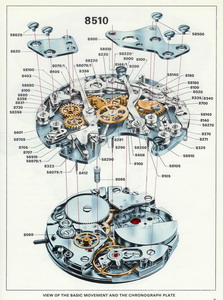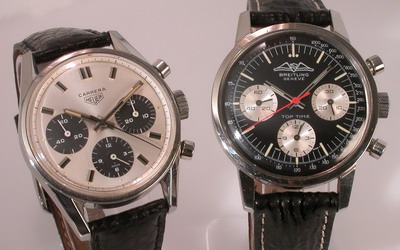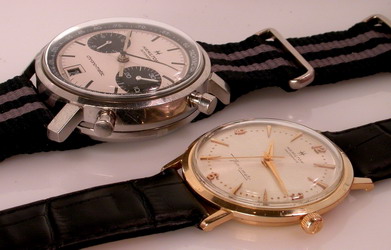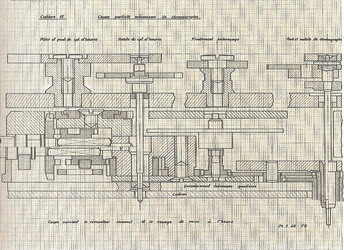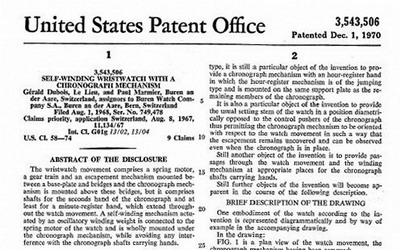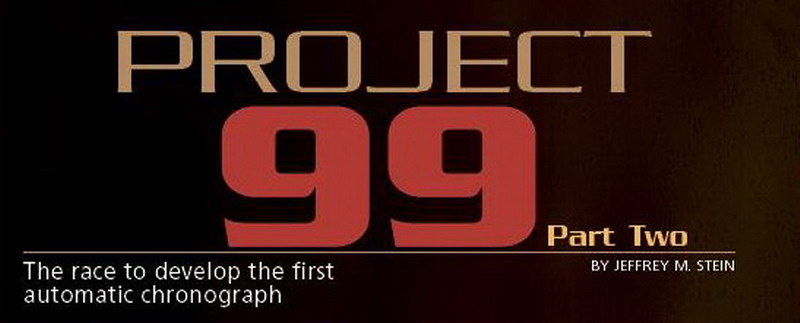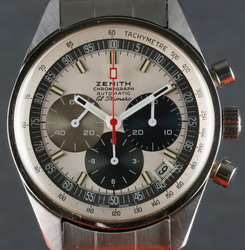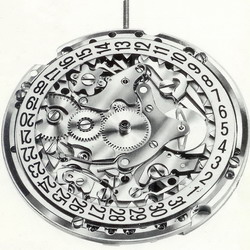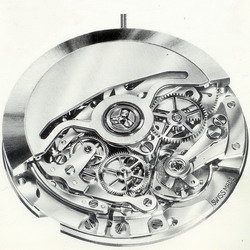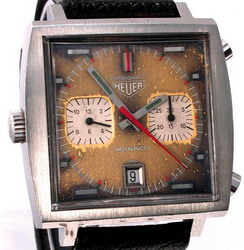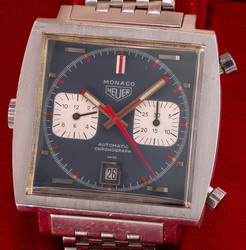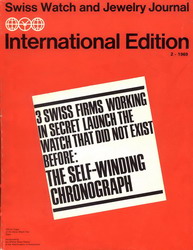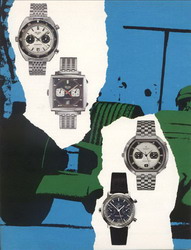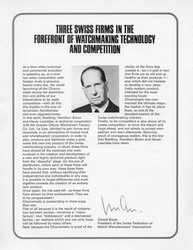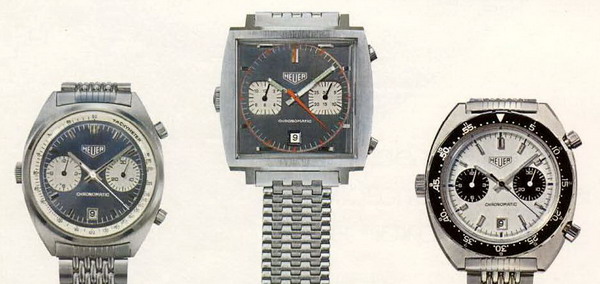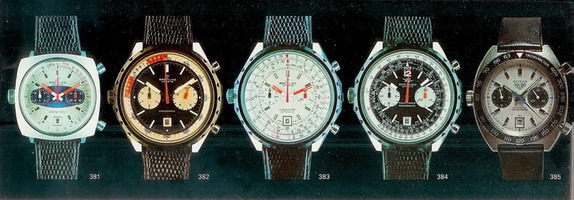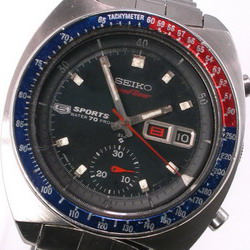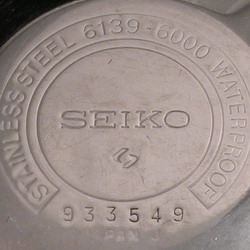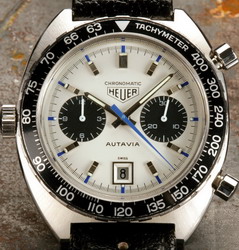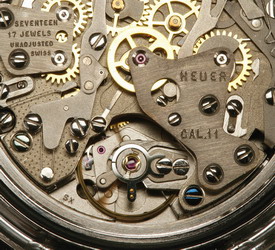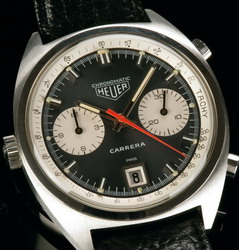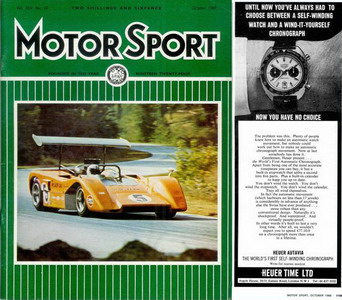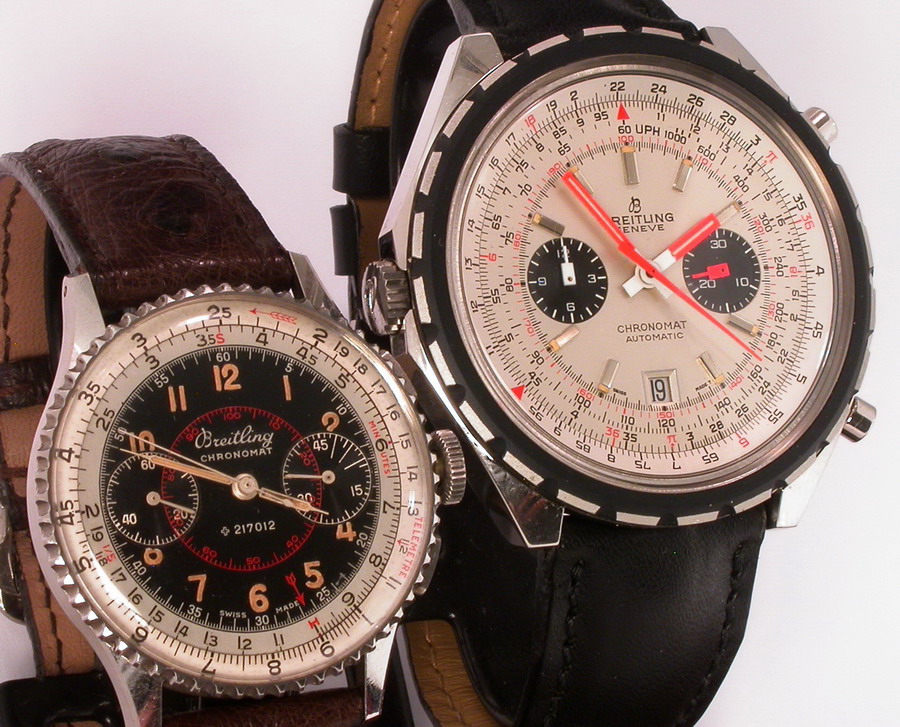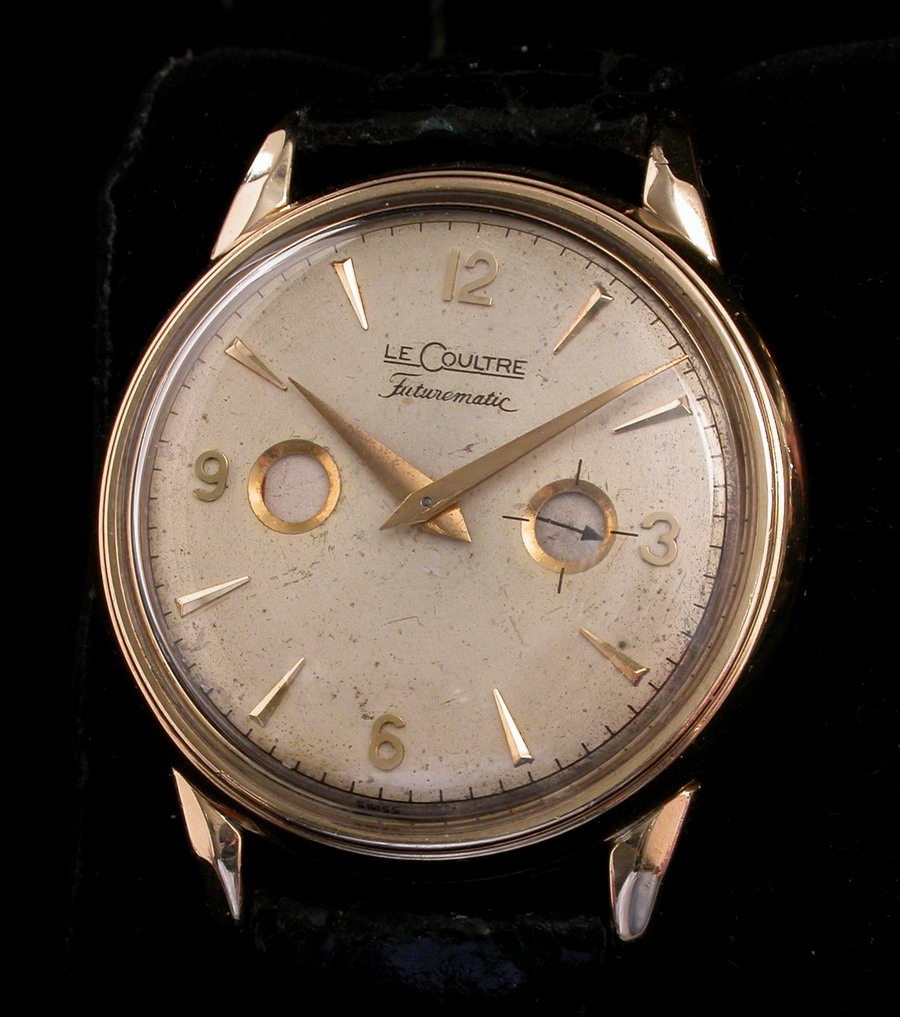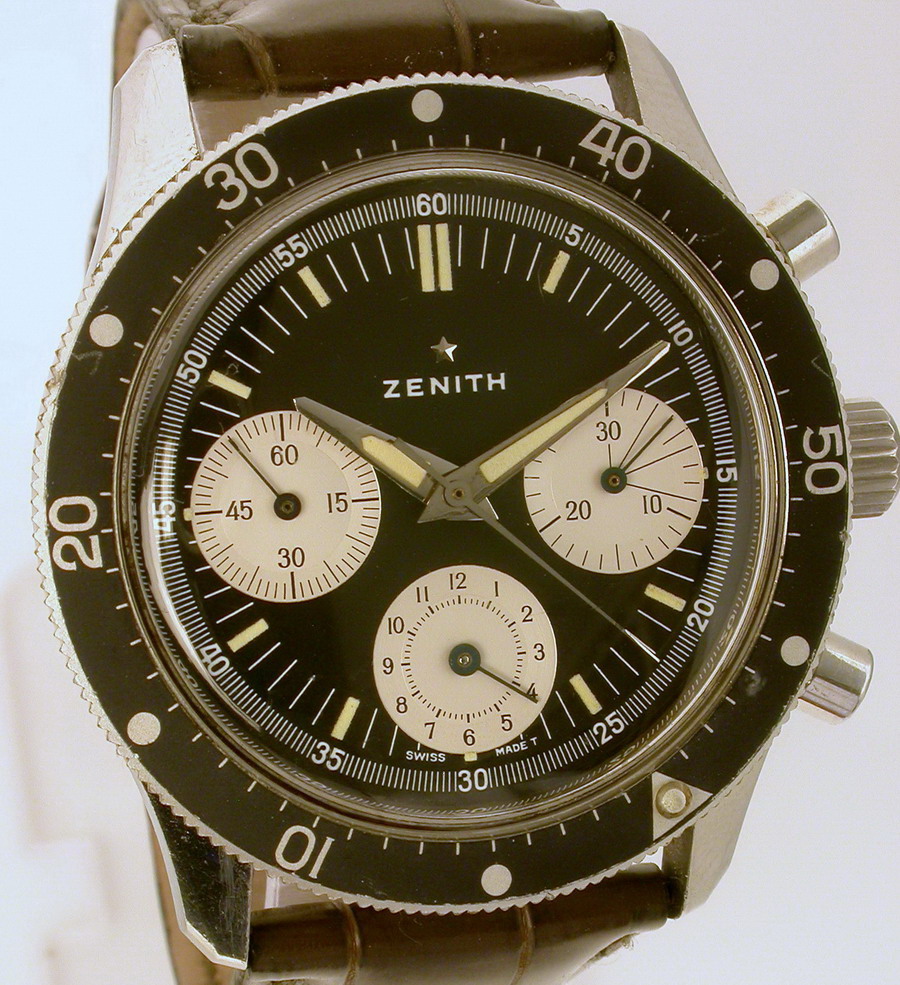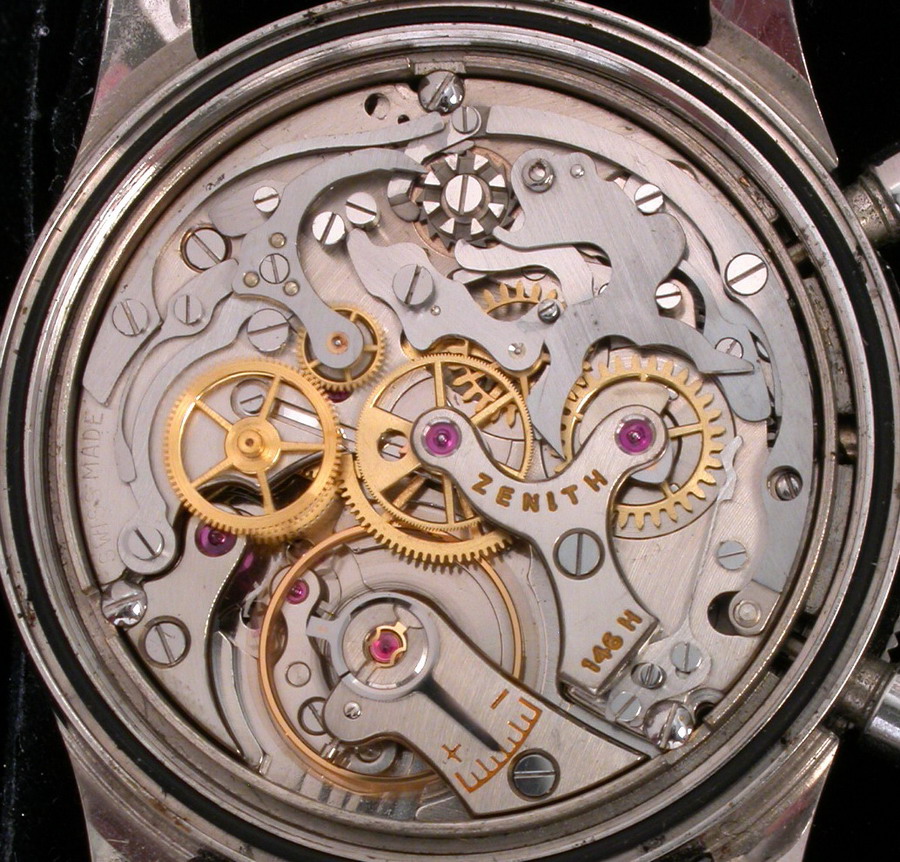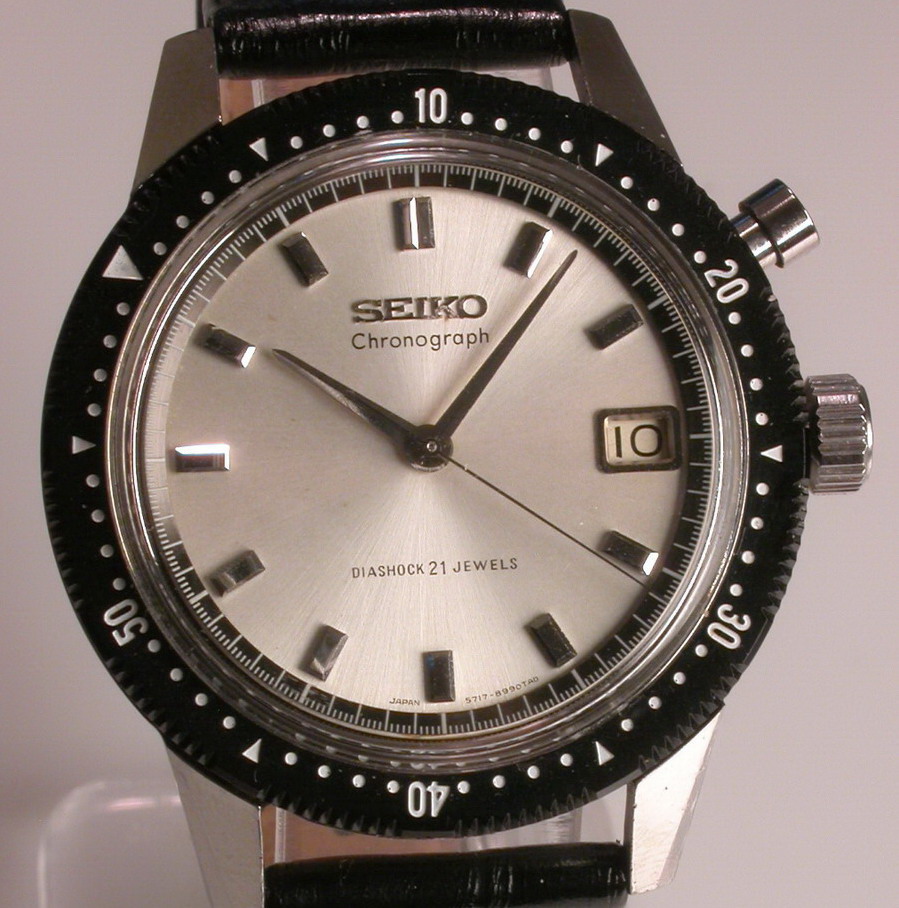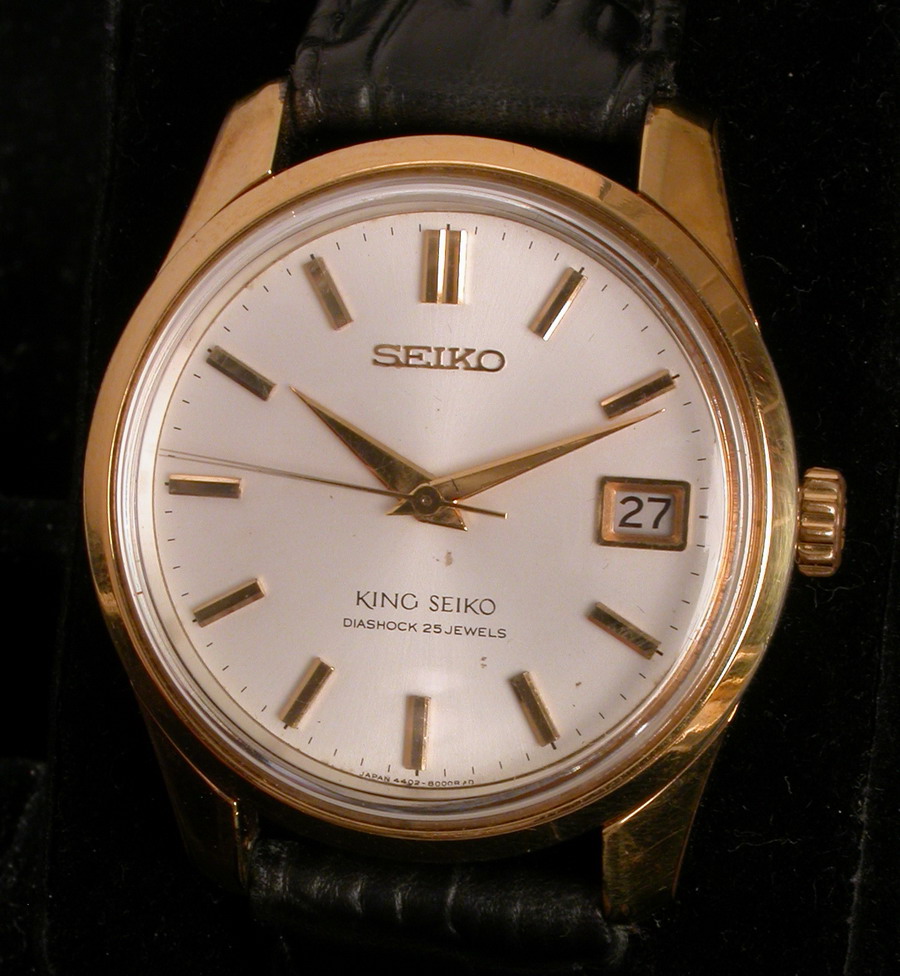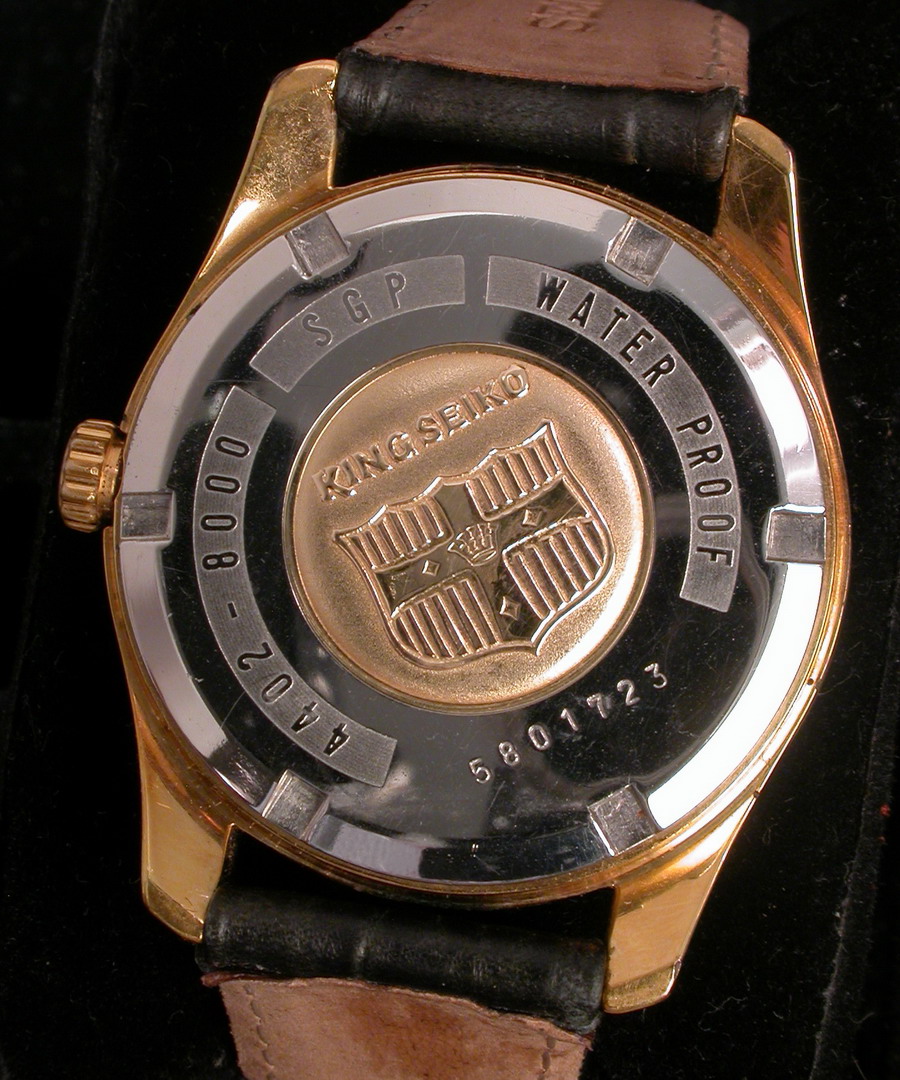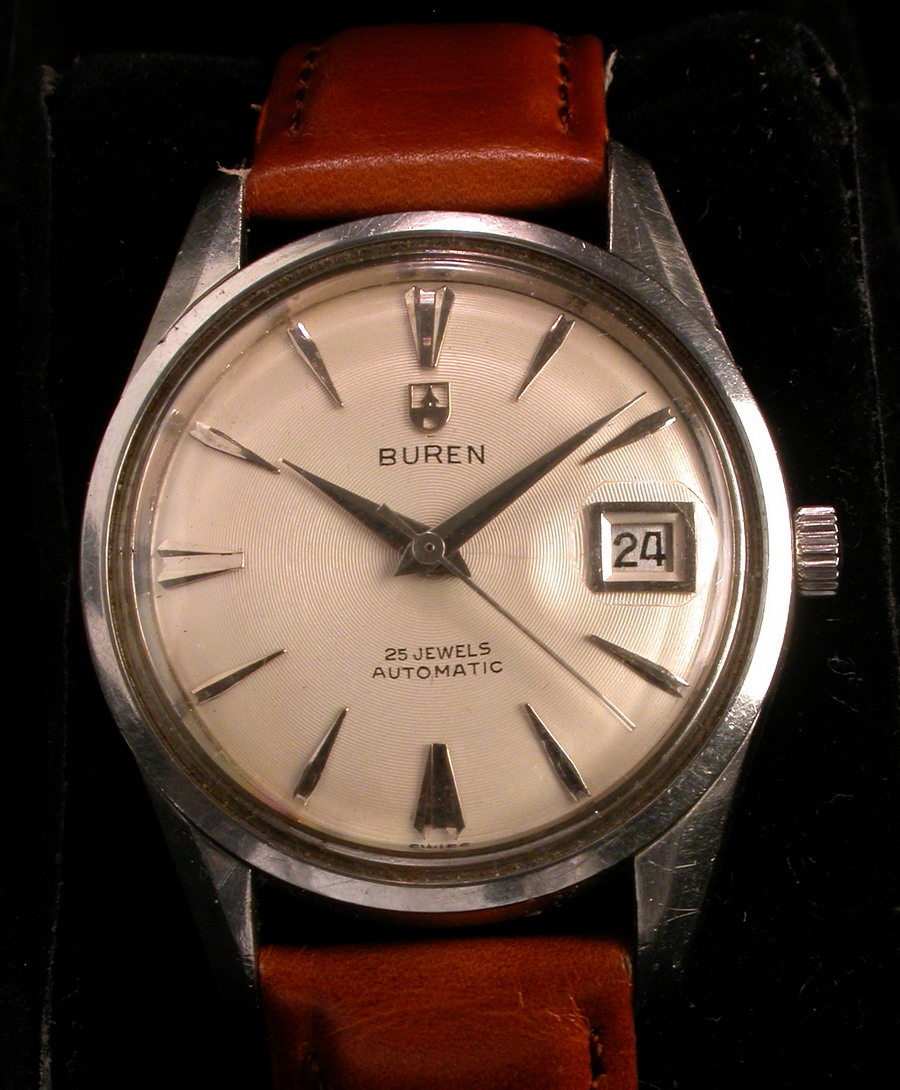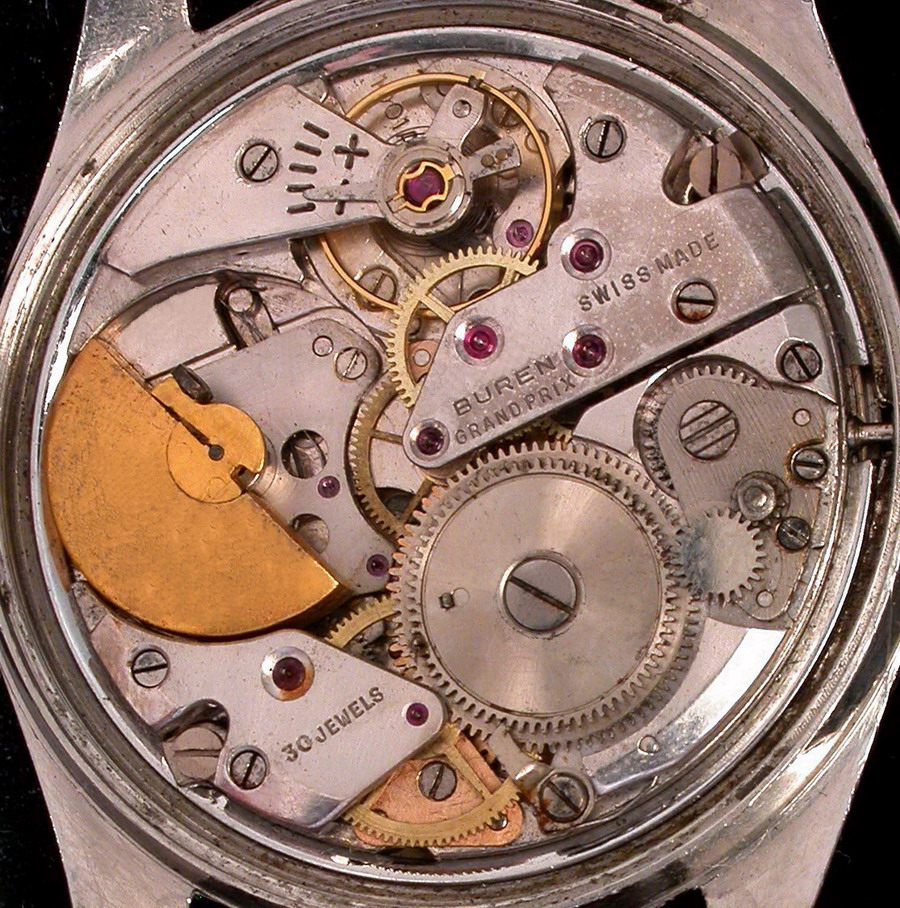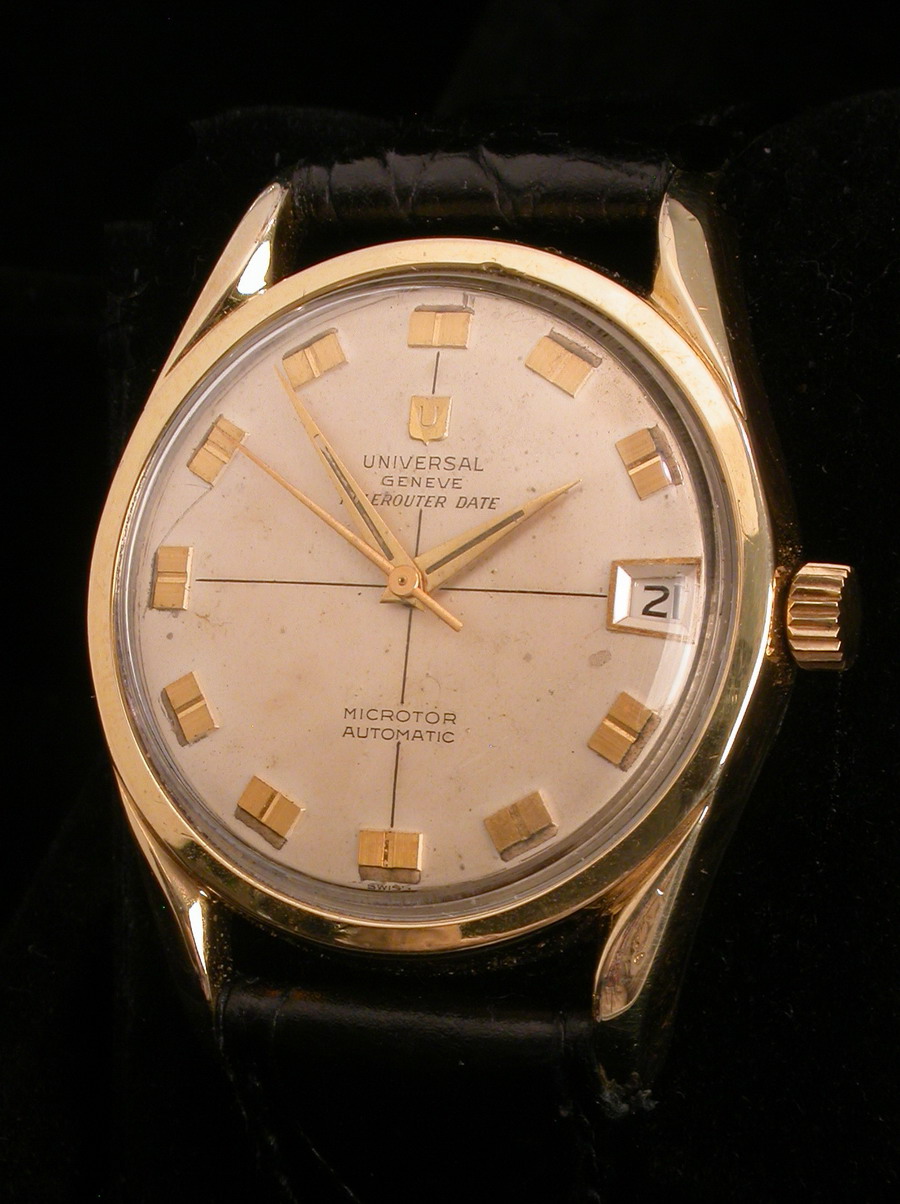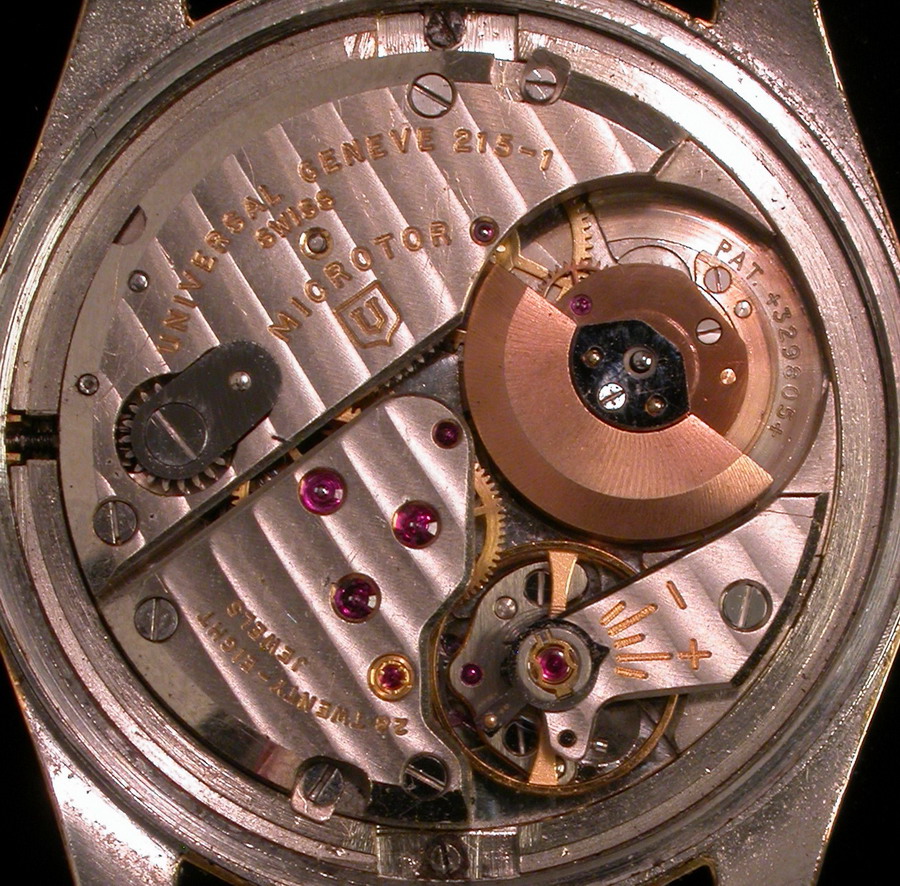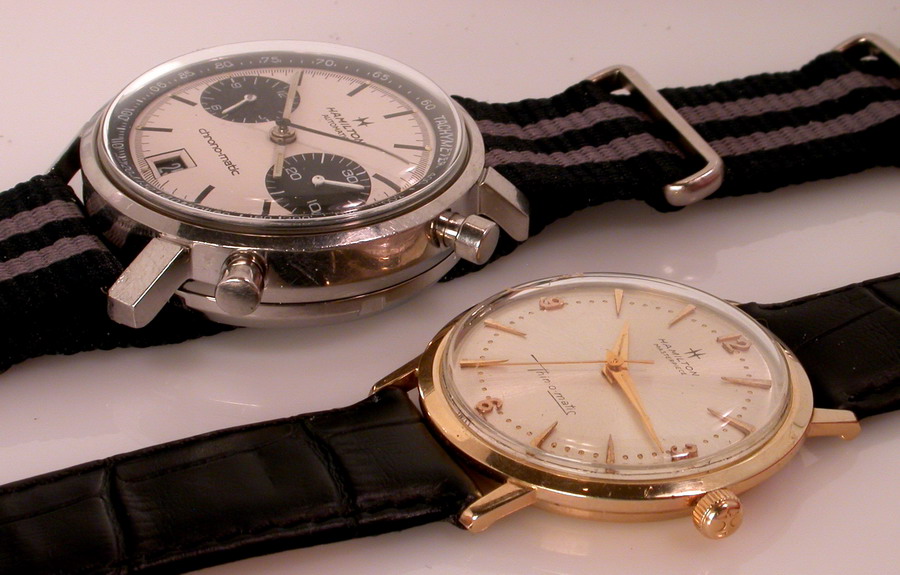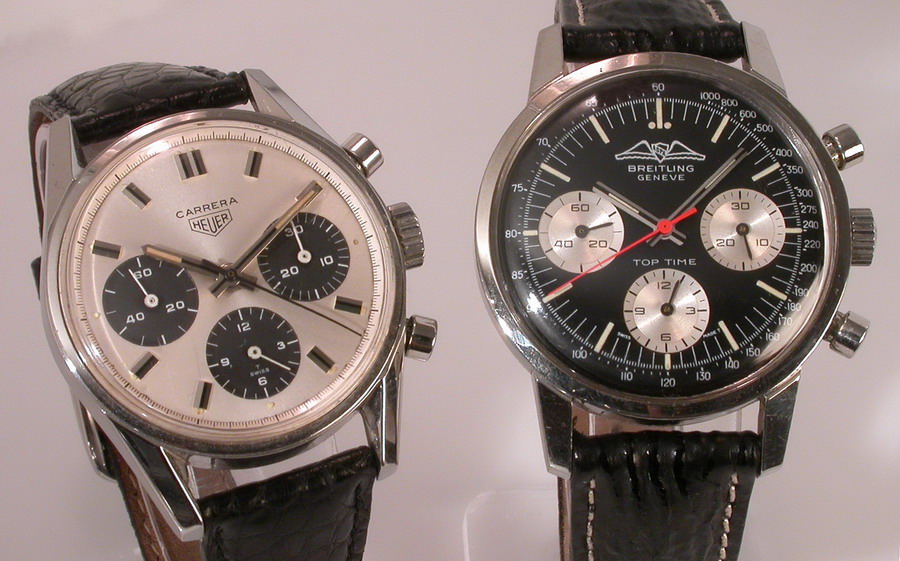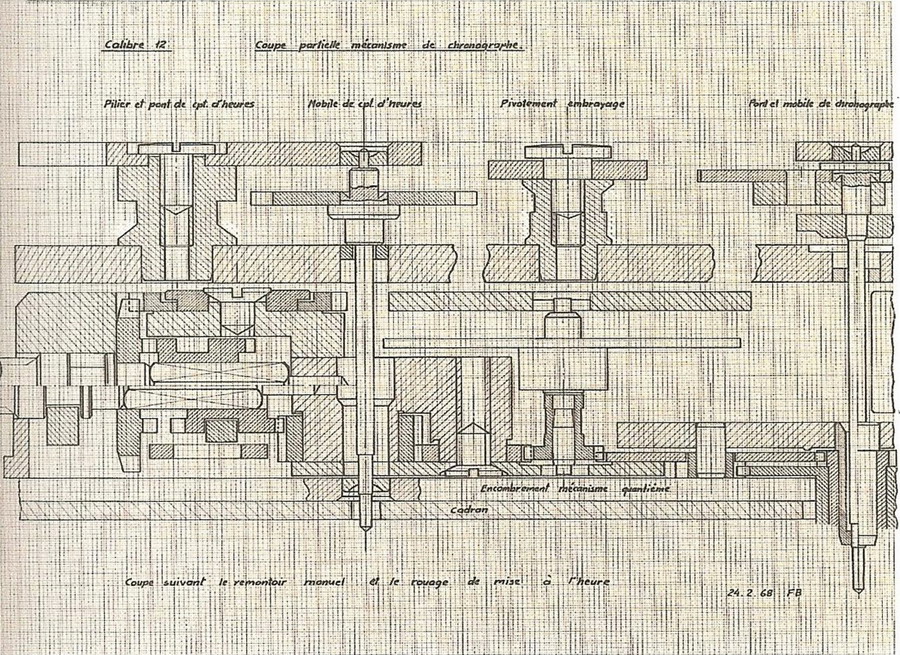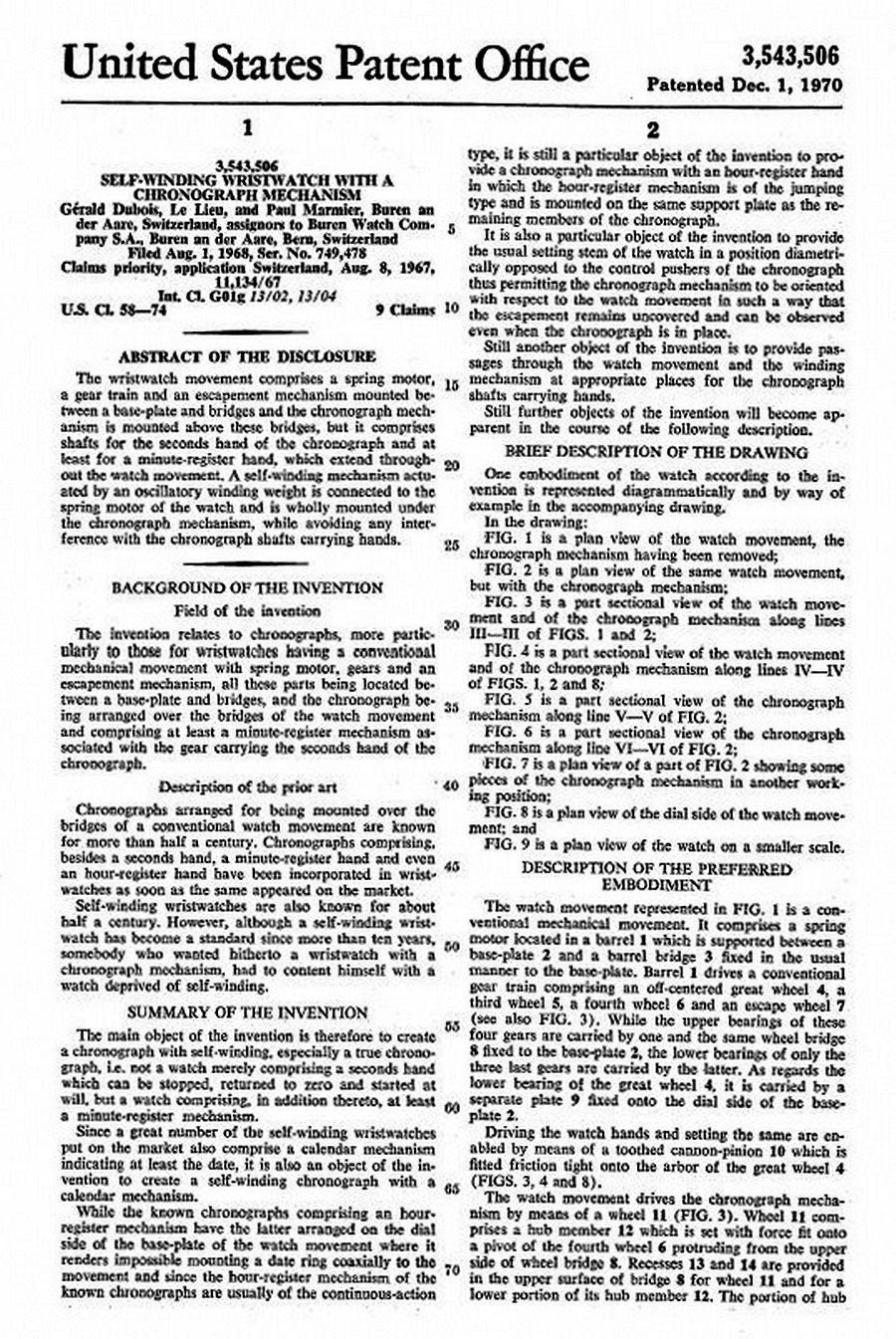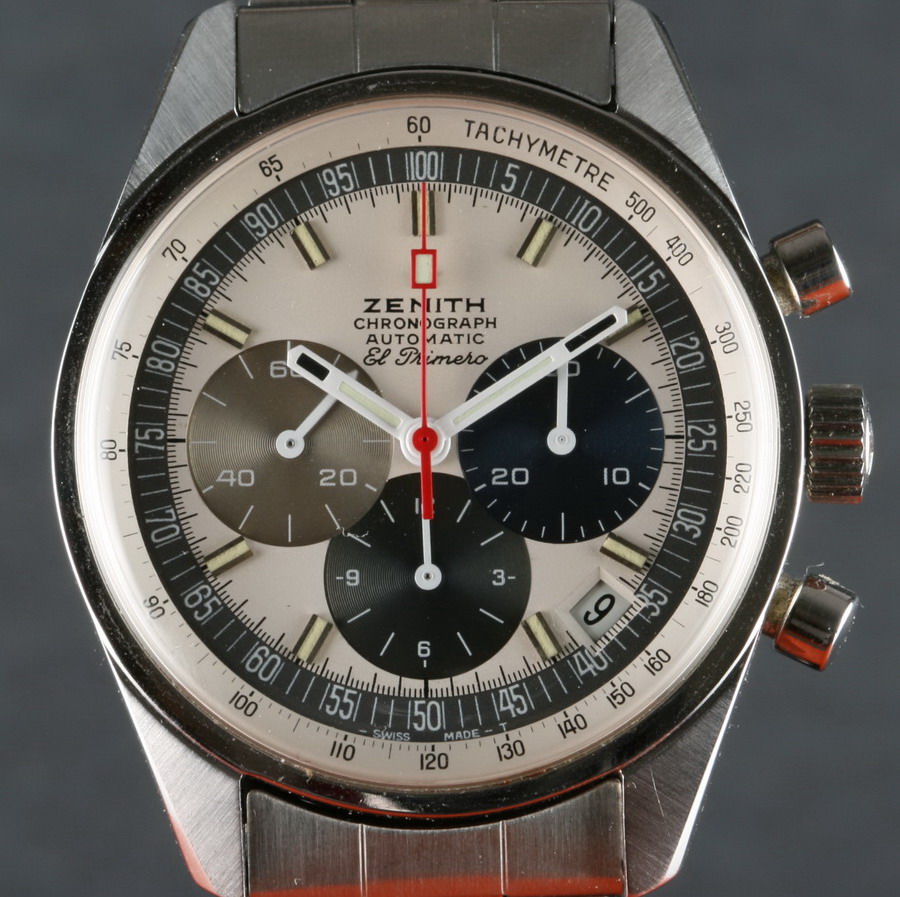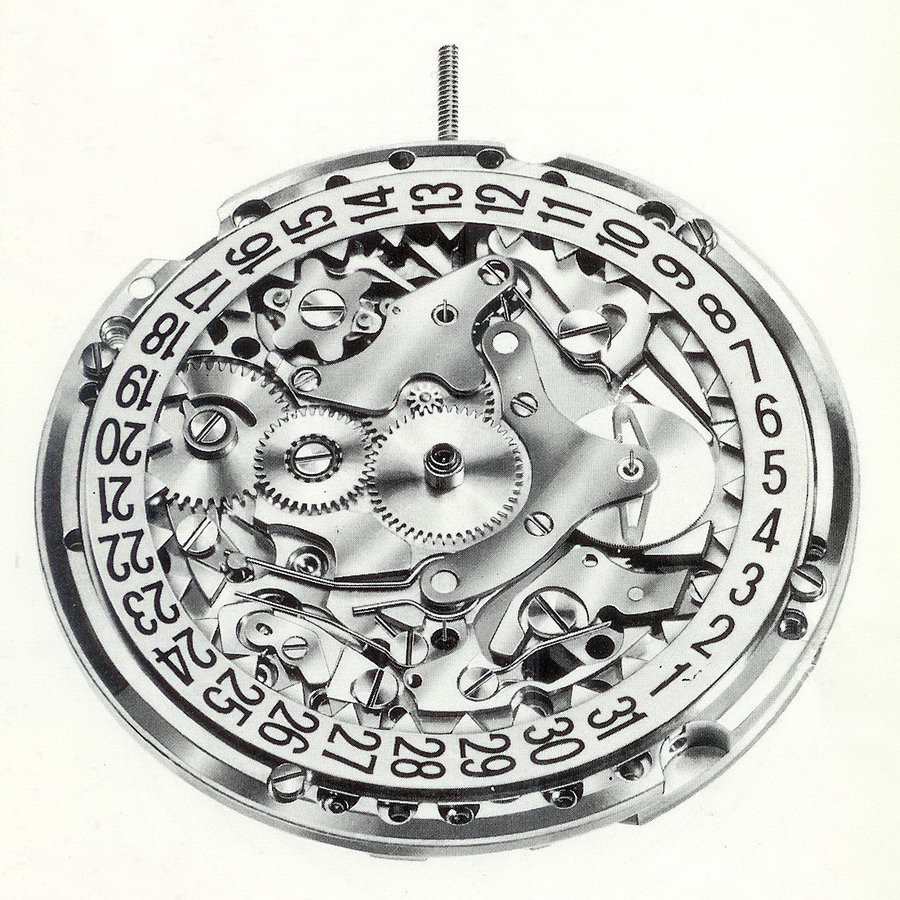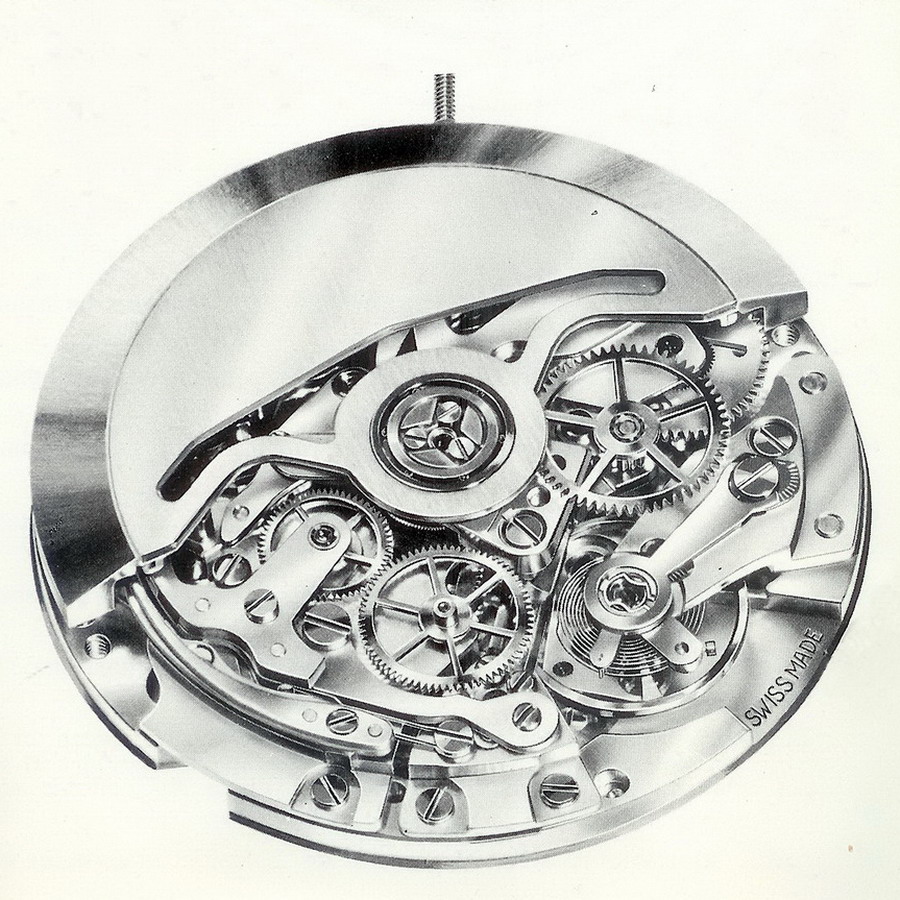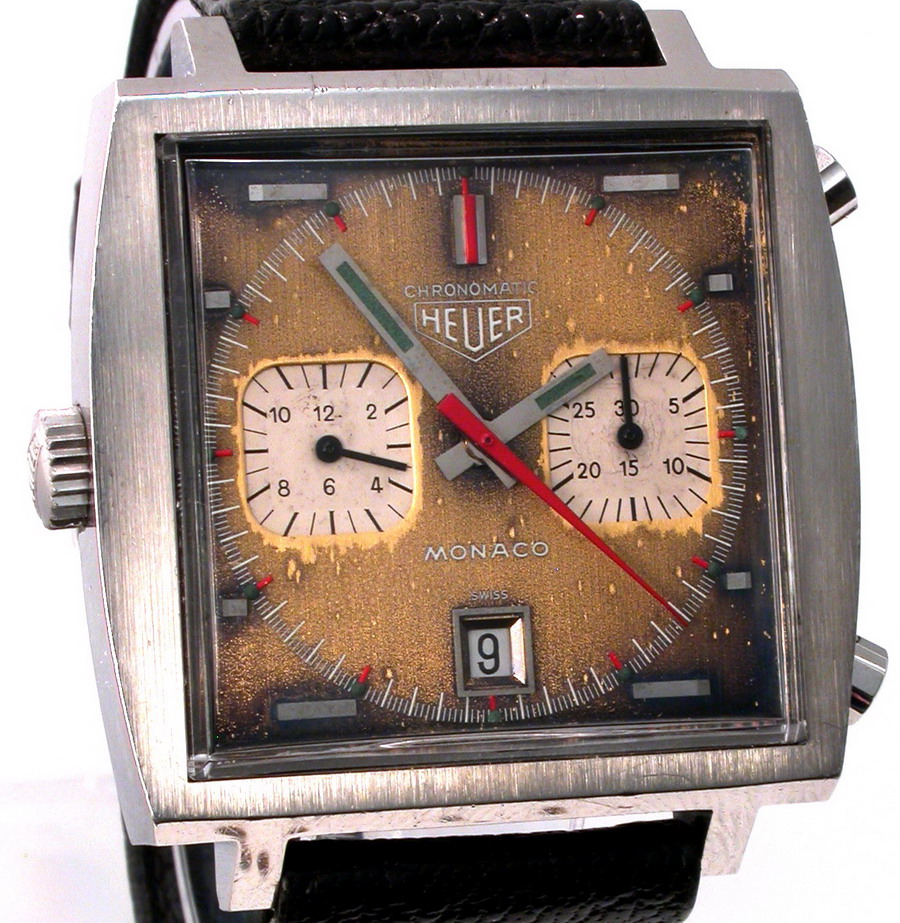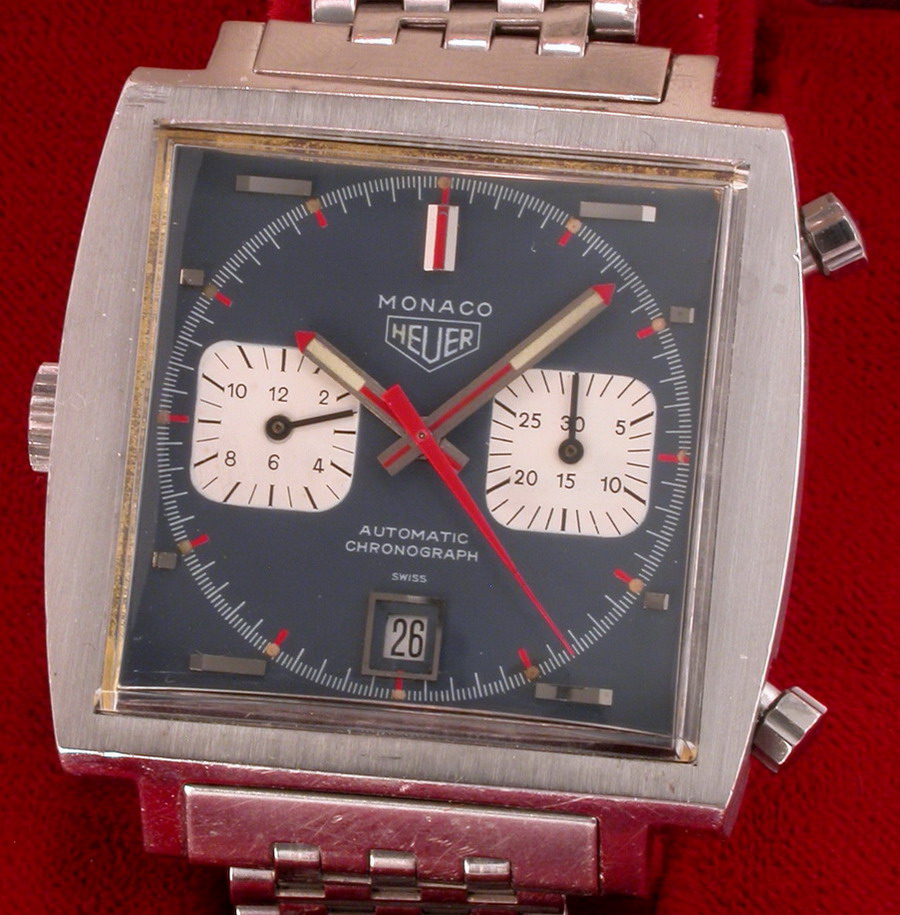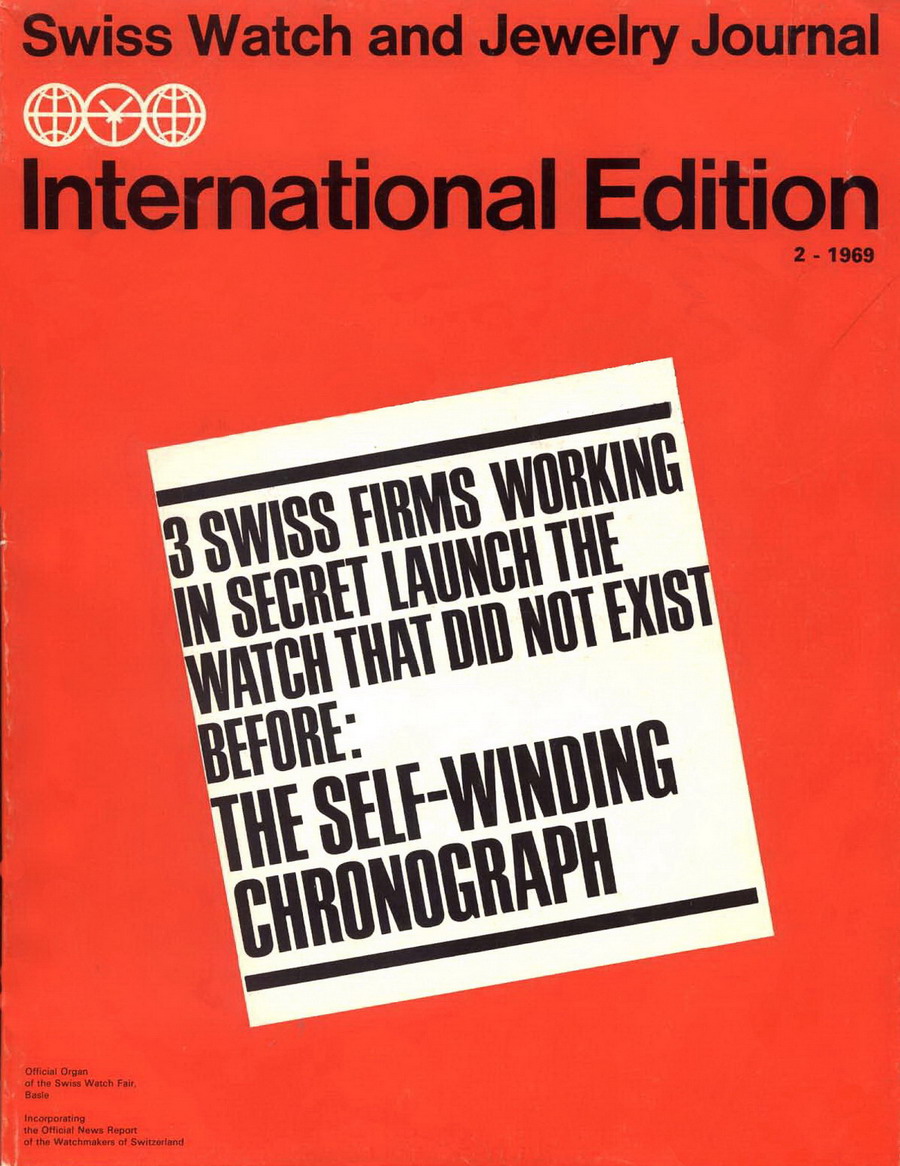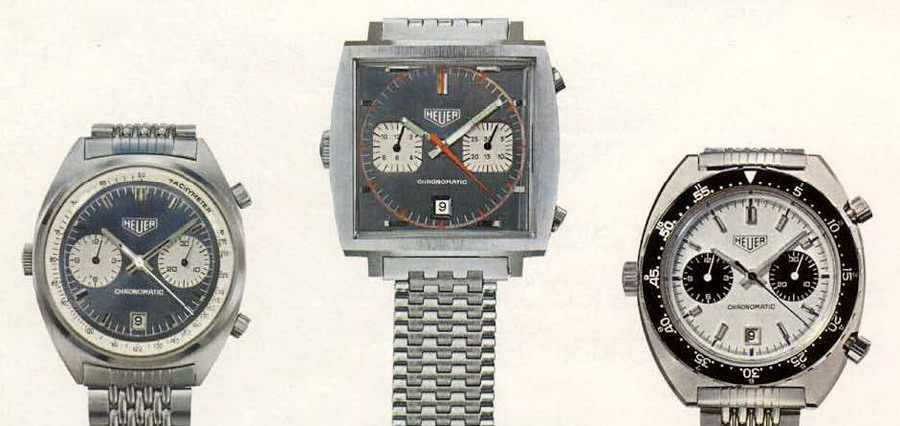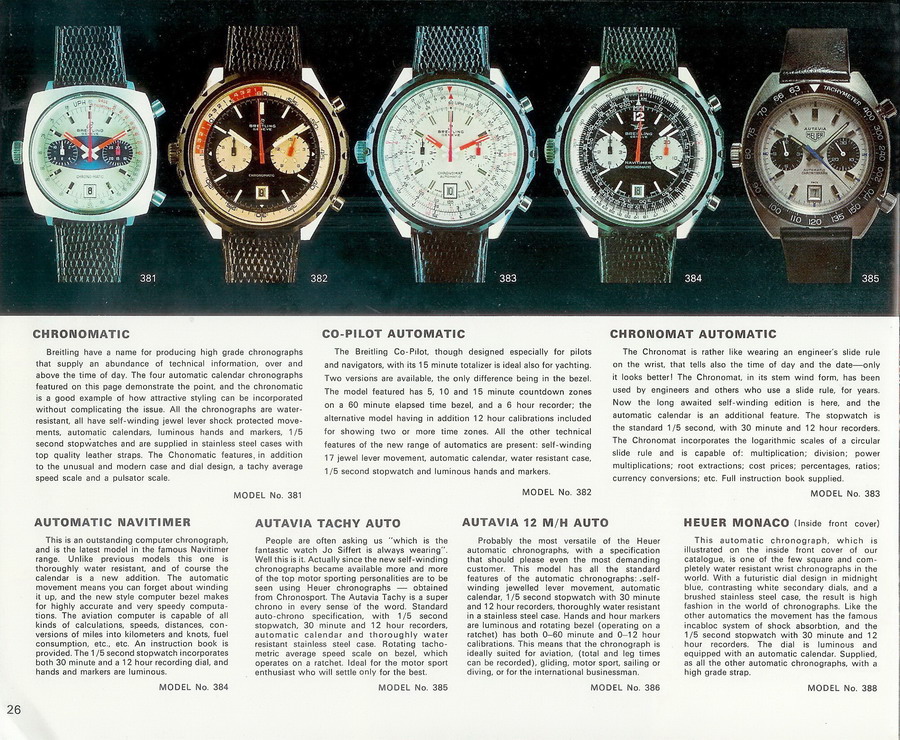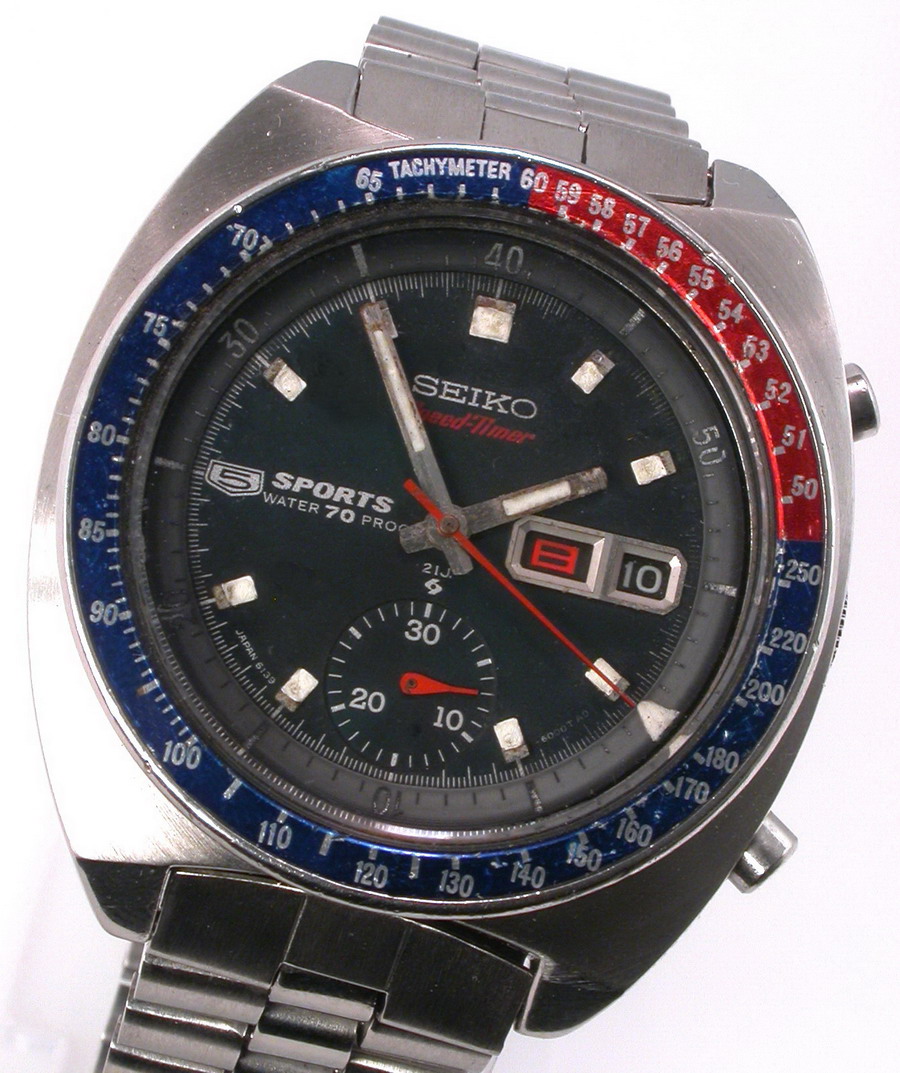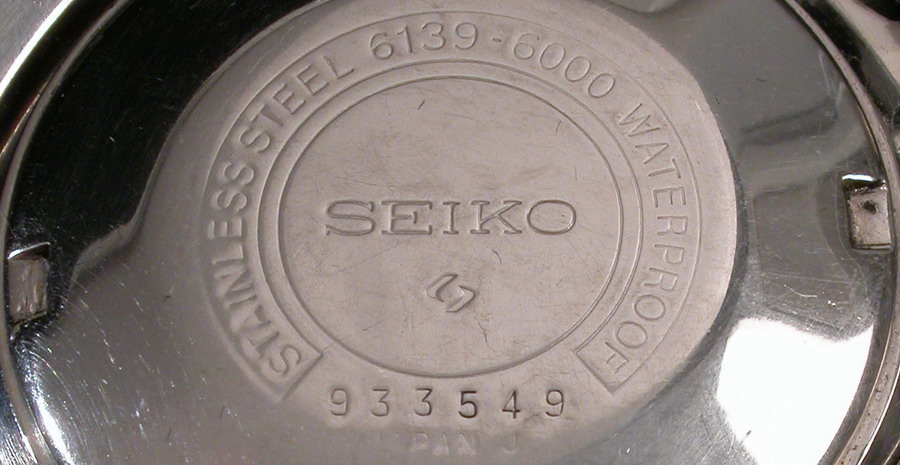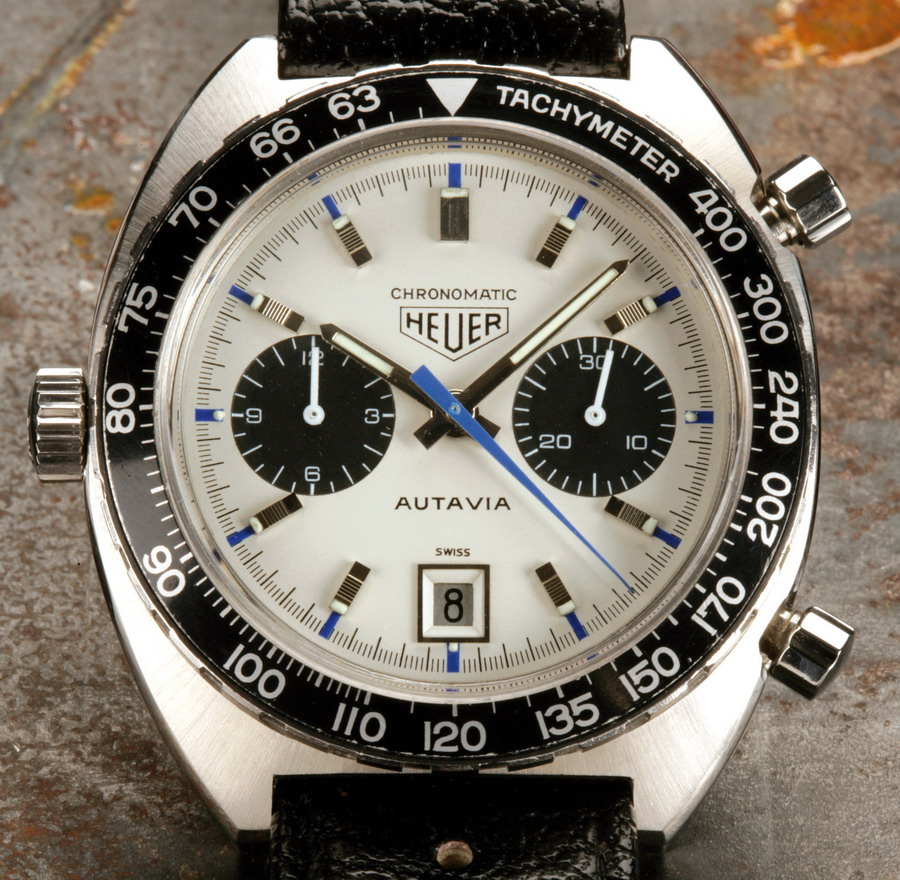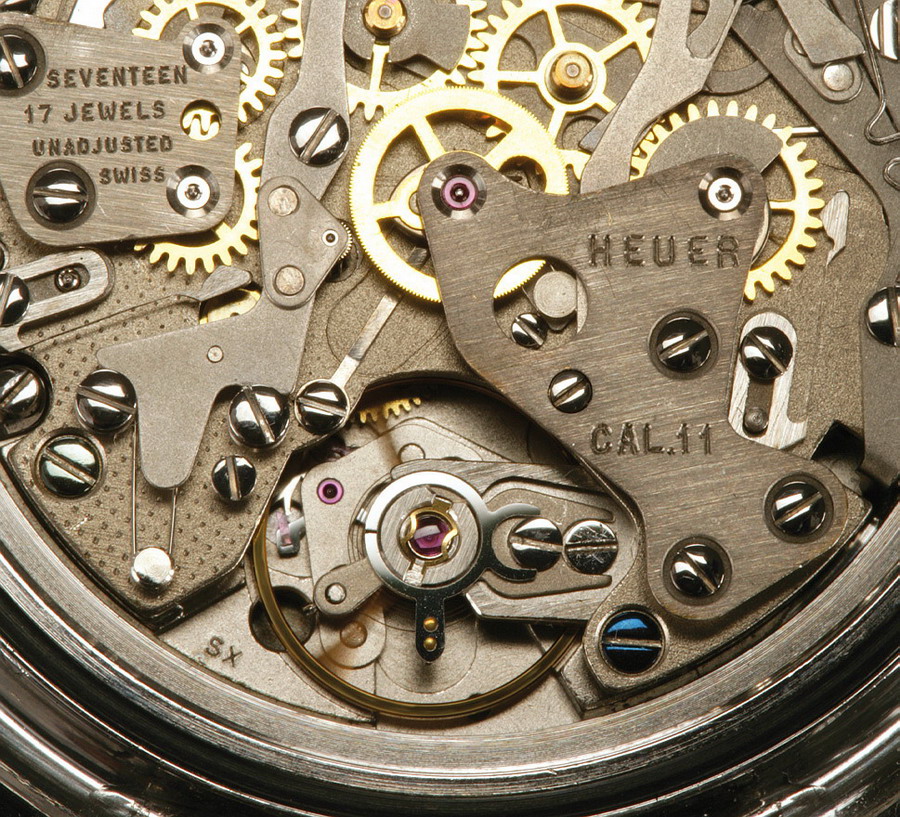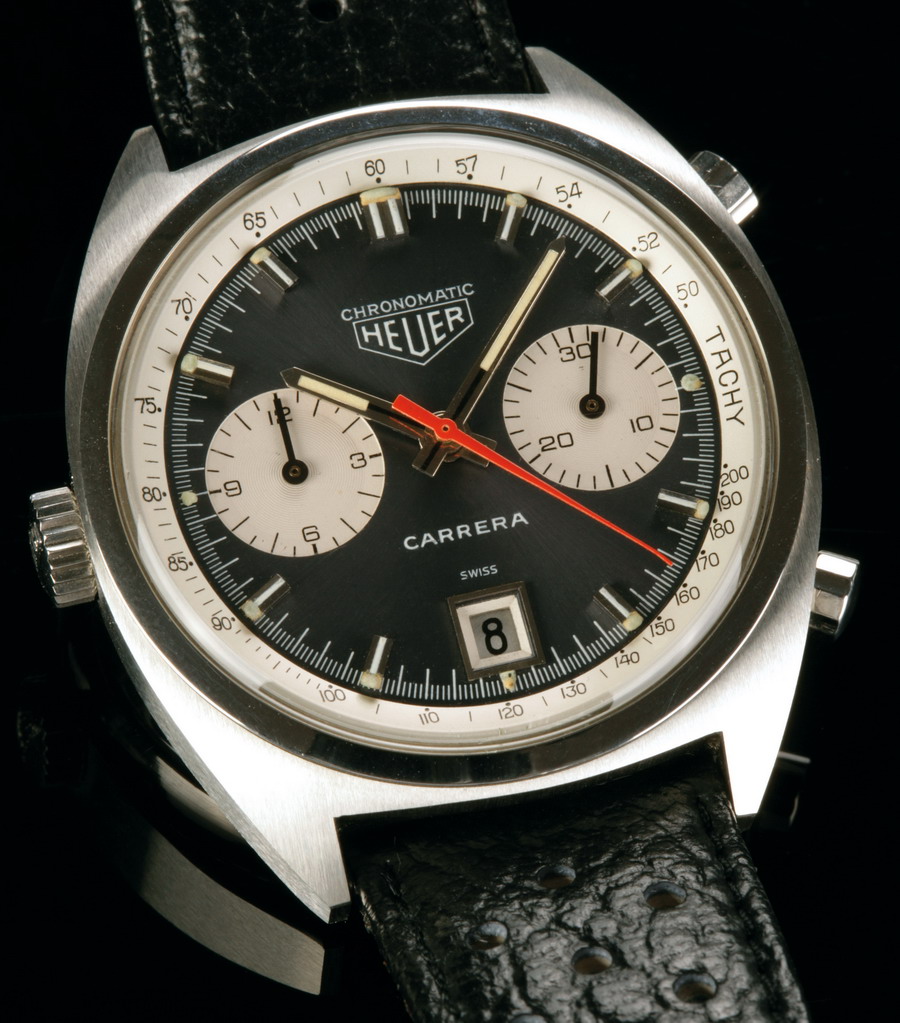|
World's First Automatic Chronograph ---------------------------------------- This webpage presents Parts One and Two of a three-part series of articles covering the history of the Chronomatic / Caliber 12 chronographs.
This webpage is an adaptation of Parts One and Two of the series, and includes additional photographs and documents that did not appear in the print versions of the articles. This page will be updated from time to time, as additional information becomes available. As always, I would welcome any questions, comments or additional information and documents. Jeffrey M.
Stein Copyright Jeffrey M. Stein, 2008, all rights reserved.
Many think of the
1960's as the golden age of motor racing.
The cars were fast; the tracks were
wide-open; the finishes were close; the
drivers were heroic, challenging death as
they challenged each other.
As much as
anything, racing in the 1960's was
characterized by the rivalries -- between
teams and between drivers. Porsche,
Ferrari and Ford at Le Mans; Porsche
versus McLaren in CanAm; the Camaros and
Mustangs on the TransAm circuit; and Lotus
and Ferrari in Formula One. There were the
heroic drivers - Andretti, Brabham, Clark,
Donahue, Foyt, Gurney, Hill, Hulme and
McLaren, among many others.
While the teams
and cars battled throughout the decade,
many of the rivalries between the drivers
were destined to last for only a short
while. Study the starting grids in the
early 1960's, and you realize how few of
the leading drivers were still racing by
the end of the decade. Many of the leading
drivers were killed; others realized that
the odds had turned against their survival
and took early retirement from what was
called the "cruel sport". Just as the
1960's might be thought of as the golden
age of competition in motor racing, this
was a memorable decade for chronographs
and the other "tool" watches. Specialized
watches were worn by drivers and their
crews when they went racing; by pilots and
international travelers as they crossed
the time zones; by divers on underwater
adventures; by the adventurers as they
climbed the tallest peaks and traveled to
the poles. The "Big Three"
of chronographs -- Omega, Breitling and
Heuer -- competed intensely with each
other, but each brand also established a
distinctive position in the market. Omega
introduced the Speedmaster in 1957; five
years later, astronaut Wally Schirra wore
one in space. By the end of the decade,
the "Speedy" was worn on the moon.
Breitling proclaimed that it was the
world's leading manufacturer of precision
instruments for aviation, with the
Navitimer becoming a part of the pilot's
uniform and the Cosmonaute becoming the
first chronograph worn into space.
Heuer was the
most dominant brand for the automotive
crowd, offering chronographs for the
racers, dashboard instruments for the
navigators, stopwatches for the crews, and
handheld, split-second chronographs for
the race officials. Indeed, "tool
watches" seemed to be coming into their
own in the early 1960's, with the leading
brands developing purpose-built watches
and chronographs for an increasingly wide
variety of demanding applications.
The
Challenge While the Swiss
watch companies continued to develop their
chronographs and other specialized
watches, at the beginning of the 1960's
they faced significant challenges. Sales
of Swiss chronographs were declining from
year to year; the legendary Valjoux and
Venus movements that powered leading Swiss
chronographs were growing old, and -- most
notably -- automatic (self-winding)
watches were enjoying increased popularity
and sales. Automatic watches
thrived throughout the 1950's, as Swiss
manufacturers introduced dozens of new
calibers. Winding systems included
full-rotors mounted to the back of
movements, "bumper" rotors that bounced
back and forth, and micro-rotors to allow
for thinner movements. The very names of
new automatic watches evidenced the
industry's excitement with the automatic
movements -- Datomatic, Depthomatic,
Geomatic, Gyromatic, Kingmatic, Powermatic
and Tempomatic, to name a few. There was
even Jaeger-LeCoultre's Futurematic, which
took the bold step of deleting the winding
/ setting crown, as if to announce that
crowns were a thing of the past. With the
increasing popularity of automatic
watches, the chronograph manufacturers
faced an imperative -- they could either
develop automatic chronographs or they
would continue to see the erosion of their
annual sales. The
Automatic is the Future. In the
1950's, the automatic watch was
the future. This Futurematic went
so far as to delete the winding /
setting crown. Commencing in the
mid-1960's, four leading watch
manufacturers engaged in the race to
develop the first automatic chronograph.
Much like Russia and the United States
competed to plant the first flag on the
moon, or like Ford set out to beat Ferrari
at Le Mans, Heuer, Breitling, Zenith and
Seiko set out to produce the world's first
automatic chronograph. Heuer and Breitling
worked in a unique partnership; Seiko and
Zenith each worked alone. The
Rivals Zenith. In
retrospect, it seems curious that Zenith
joined in the competition to develop an
automatic chronograph. Founded in 1865,
Zenith had established its reputation
during the 1940's and 1950's as a
manufacturer of chronometers and watches
for the military. As a true manufacture,
Zenith produced its own movements for its
chronometers. Still, Zenith offered only a
limited line of chronographs and Zenith
sourced the movements for its chronographs
from other companies, primarily Excelsior
Park. Zenith's relatively small presence
in the world of chronographs is evidenced
by the fact that Zenith was not a member
of the Swiss association of chronograph
manufacturers. In 1960, Zenith
acquired Martel Watch Company, a producer
of movements for chronographs and other
complicated watches (such as calendar and
moonphase watches). Martel was well-known
as the supplier of chronograph movements
for Universal Geneve and other respected
brands. By acquiring Martel, Zenith
broadened its offering of chronographs,
and enhanced its capabilities in the
design and production of chronograph
movements. Soon after its acquisition of
Martel, Zenith adapted the Martel
chronograph movement that had been used in
the Universal Geneve caliber 285 to become
the Zenith 146 series of movements,
featuring the 146-D (a two-register
movement, with 45-minute capacity) and the
146-H (a three-register, tri-compax
movement with a 12-hour
recorder). After
Zenith acquired Martel, in 1960,
it had the capacity to produce
movements for its chronographs,
including the 146H movement.
Soon, Zenith would go much
further, as it sought to produce
the world's first automatic
chronograph. Zenith embarked
on the design of an automatic chronograph
in 1962, hoping to introduce this
revolutionary chronograph to mark the
company's 1965 centennial. Seiko. Founded in 1881,
as a manufacturer of clocks, Seiko
manufactured its first wristwatches in
1913, with the "Seiko" name first
appearing on a watch dial in 1924. In
1955, Seiko produced Japan's first
automatic wristwatch, and in 1960, the
company launched its Grand Seiko line of
watches, designed to represent the highest
development of Japanese watches.
In
1964, Seiko introduced its very
first chronograph (Reference
5717), a one-button timer with 60
second capacity. With the
production of more accurate
watches in the mid-1960's,
including the King Seiko and
Grand Seiko, the company was
prepared to challenge the Swiss
watch manufacturers in both
watches and
chronographs. To bolster its
international reputation for quality, in
the mid-1960's, Seiko began to compete in
the Swiss Observatory Chronometer
competitions, enjoying remarkable success
in these endeavors, and bringing worldwide
recognition to the company. Nineteen
sixty-four was a momentous year for the
company, as Seiko was the official
timekeeper of the Tokyo Olympic Games, and
also introduced it first chronograph, a 60
second timer, with a rotating bezel
(Reference 5717). With its success in
manufacturing rugged, accurate mechanical
watches, Seiko positioned itself to
challenge the dominance of the Swiss watch
industry (even before the advent of quartz
watches). Heuer Founded in 1860,
Heuer introduced the first "wrist
chronographs" around 1914, and had a
long-standing reputation in the production
of chronographs and sports timing
equipment, especially stopwatches,
split-second timers and timing systems.
From pilots'
chronographs in the 1930's, to triple
calendar chronographs in the 1940's, to
rugged chronographs in the 1950's, Heuer
offered a broad range of chronographs. In
1958, Heuer introduced its Master Time and
Monte Carlo dashboard timepieces, and soon
these "Rally Master" pairs were used by
over half the leading rally teams. In the
early-1960's, Heuer introduced two
chronographs that would be popular with
the racers -- the Autavia and the Carrera
-- both of which were powered by Valjoux
movements. Ironically, Heuer also produced
a line of automatic watches, but the
company abandoned these watches in the
late-1950's, in order to focus on the
production of chronographs. Buren Founded in
1873, the Buren Watch Company developed
numerous calibers over the years, always
manufacturing its own parts. Buren
introduced its first automatic watch in
1945, and from the start was seeking to
develop thinner automatic movements. Its
Caliber 525 utilized a pendulum winding
mechanism, recessed within the movement,
rather than a rotor at the back of the
movement. Ultimately, this approach was
not successful, so 1952 saw Buren's first
use of an automatic watch powered by a
rotor. In 1953, Buren offered the smallest
automatic watch with a power reserve
indicator. Origin
of the Species. With Buren's
development of micro-rotor
powered movements,
Charles-Edouard Heuer began to
believe that a modular automatic
chronograph might be feasible. By
placing a smaller rotor in the
same plane as the other movement
components, designers avoided the
additional thickness of a
full-sized rotor. In 1954, Buren
patented its "micro-rotor", which allowed
it to produce the flattest possible
automatic watches. By shrinking the
diameter of the rotor (to fit within the
radius of a comparable movement), and
locating this rotor in the same plane as
other components of the movement, Buren
avoided the need to place the rotor behind
the movement. Buren's first watches using
the micro-rotor were the "Super Slenders"
(calibers 1000 and 1001), introduced in
1957, with this automatic system also
known as the "Intramatic" system.
Buren also
licensed its technology to other
companies, including IWC, Baume &
Mercier, Bulova and Hamilton. After a
patent dispute, Buren also began to
license its micro-rotor technology to
Universal Geneve. Microrotor
Rivals. In its microtor
movements, Universal Geneve used
a near-identical approach to that
of Buren. After a patent dispute,
Universal Geneve was required to
pay Buren a royalty fee on each
of its microrotor
watches. The
Beginnings The Caliber 12 /
Chronomatic movement had its origins in
the late 1950's when Charles-Edouard Heuer
-- then the President of Ed. Heuer &
Co. -- began to consider how the company
might produce an automatic chronograph.
Heuer studied the microrotor movements
being produced by Buren and began to
explore the idea of mounting a chronograph
mechanism on top of this movement.
The idea was
short-lived, however, as even the
combination of the thinnest Buren movement
and the thinnest chronograph mechanism
would be too thick to compete effectively
against the sleek watches of the era.
(Remember this was also the period of
Hamilton's "Thin-O-Matics"!)
All this changed,
however, in 1962, when Buren introduced an
even thinner microrotor movement -- the
Caliber 1280 "Intramatic" movement. With
the thickness of this movement reduced
from 4.3 millimeters to 3.2 millimeters,
it now seemed possible to build a suitably
thin automatic chronograph. At this point,
Heuer faced the question of who could
build this thinnest-possible chronograph
module, to be mated with Buren's base
movement. Dubois-Depraz Of the four
companies involved in the development of
the Chronomatic movement, Dubois-Depraz is
surely the company least known to the
public. Founded in 1901, Dubois-Depraz
didn't manufacture watches or movements,
and it didn't produce chronographs, but as
the leader in designing the so-called
"complications", Dubois-Depraz worked with
watch companies to make simple, base
movements into more complicated watches or
chronographs. Starting with a
simple time-of-day movement, Dubois-Depraz
had the ability to add a broad variety of
complications, including a chronograph,
power reserve indicator or calendar. Heuer
had called on Dubois-Depraz to develop the
movements for Heuer's 7700 series of
stopwatches. This work culminated in 1967,
with Dubois-Depraz's developing a special
module for Heuer's Monte Carlo stopwatch
(Caliber 7714), so that a single pusher
would simultaneously reset the minute and
second hands, as well as the hour
disc. The
Heart of the Partnership. Rather
than a traditional integrated
chronograph, the Chronomatic team
used a modular approach,
combining the Buren base movement
with a newly designed
Dubois-Depraz chronograph module.
This modular approach is
emblematic of the partnership
between the four firms -- Heuer,
Breitling, Buren and
Dubois-Depraz. Based on these
experiences, Heuer retained Dubois-Depraz
to study the feasibility of developing a
chronograph module that could be mated
with the Buren movement. Ironically,
Gerald Dubois (then president of the
company) had conducted comprehensive
research into the design of a chronograph
module to be used with the Buren
microrotor movements, and had discussed
the idea with Buren. When
Dubois-Depraz confirmed the feasibility of
this project, the Chronomatic venture was
almost ready for action. The Chronomatic
would be a 17 jewel lever movement,
consisting two essential elements
described as being "totally independent":
the Buren base movement (including the
self-winding and calendar mechanisms), and
the Dubois-Depraz chronograph module, a
plate holding a newly-designed chronograph
mechanism. In short -- a modular automatic
chronograph. Breitling Since its
inception in 1884, Breitling was known for
its production of chronographs and
precision counters for scientific and
industrial purposes. As Heuer was the
brand most closely associated with
automobile racers and racing, Breitling
became recognized as the brand most
closely associated with pilots and flying.
In the 1930's, Breitling began to produce
on-board chronographs for aircraft, and
also introduced the first two-button
chronographs, allowing the user to stop
and re-start the chronograph (time-out and
time-in functions). In 1942,
Breitling launched the Chronomat, the
first chronograph fitted with a circular
slide rule on the dial and bezel; 10 years
later, Breitling introduced its legendary
Navitimer, a three-register chronograph
equipped with a circular slide rule, as
well as a "navigation computer" capable of
handling all calculations called for by a
flight plan. At the request of
astronaut Scott Carpenter, Breitling
produced the Cosmonaute in 1963, a 24-hour
version of the Navitimer. Other Breitling
chronographs of the era included the Top
Time, Cadette, Unitime and Co-Pilot, all
designed for adventurers. Completing
the Partnership As Heuer, Buren
and Dubois-Depraz stood ready to embark on
the development of their automatic
chronograph, there was one last hurdle
between the venture and the commencement
of it work . . . this hurdle being the
capital required to fund the project.
Development of an automatic chronograph
would be a costly venture, more than Heuer
and Buren could undertake as two
relatively small, independent
companies. To address this
need, Jack Heuer (then President of
Heuer-Leonidas) did something unusual, for
the 1960's or for today. He approached his
friend Willy Breitling (then President of
Breitling) to discuss the idea of a
partnership. Though they were direct
competitors in their lines of chronographs
and stopwatches, Jack Heuer has explained
their cooperation on the Chronomatic
project in the simplest
terms. "Heuer was a very
strong brand in the United States and UK
markets, but weaker in Europe. Breitling
was strong in Italy and France, but had
little presence in the US or the UK. Both
of us needed an automatic chronograph; it
would be difficult for either of us to
develop it, working alone. This was a
perfect opportunity to create a
partnership in which both partners --
though entering as rivals -- could
strengthen their
positions." When
Rivals Became Partners. Heuer and
Breitling were direct competitors
in the market for sports
chronographs, but created a
partnership to develop the
Chronomatic automatic
chronographs. The Carrera and the
Top Time were both from the
mid-1960's. Breitling
courtesy of P.
Taubman. With
Dubois-Depraz having confirmed the
feasibility of building a modular
chronograph, and Breitling and Heuer
committed to funding this unique
partnership and sharing its output, Heuer
and Breitling then approached Buren with
their proposition of a partnership.
Joining the Chronomatic team was
attractive for a small company such as
Buren. Compared with the small customers
who bought Buren's movements, Heuer and
Breitling would constitute a significant
opportunity for Buren. With that, the
Chronomatic team was fully formed -- two
leading chronograph brands, the leading
manufacturer of thin automatic movements,
and the leading specialist in developing
chronographs and other
complications. Hamilton In 1966, while
development of the Chronomatic movement
was underway, Buren was acquired by
Hamilton Watch Company (of Pennsylvania).
Hamilton transferred much of its own
production to the Buren factory, in
Switzerland, and through the Buren
acquisition, became a partner in the
development of the Chronomatic movement.
While Heuer and Breitling were surprised
to have Hamilton as their new partner,
Hamilton had a limited history in the
production of chronographs and would not
represent a threat to the founding
partners, using only a small portion of
the movements produced by the Chronomatic
group. From
Thin-O-Matic to Chrono-Matic. It
was the Buren Intramatic movement
(used in this Hamilton
Thin-O-Matic watch) which allowed
the development of the Caliber 12
movement (used in this Hamilton
Chrono-Matic). Buren's microrotor
was at the heart of both these
movements. Project
99 The members of
the Chronomatic group realized the
importance of secrecy in their work. With
four partners in the group (and eventually
five), and a host of other companies that
would come to be involved in the
production of cases, dials and other
components, there were many people
involved in the day-to-day operation of
the project. Confidentiality was of utmost
importance, as the Chronomatic group raced
against unknown opponents to produce the
first automatic chronograph.
Throughout the
term of the project, employees of the
participating companies were prohibited
from uttering the phrase, "automatic
chronograph". Jack Heuer recalls that his
father, having served as a Brigadier
General in the Swiss Army, insisted that
the Chronomatic project have a code name.
With that, this unusual partnership became
"Project 99". The
Laboring Oar. Dubois-Depraz had
the most challenging role in the
Chronomatic partnership,
developing a chronograph module
from scratch. The module relied
on levers and cams, in the place
of the chronograph's classic
column wheel. Of the four firms
participating in the development of the
Chronomatic movement, Dubois-Depraz had
the most challenging assignment. While
there would be relatively few
modifications in Buren's base movement,
Dubois-Depraz would develop the
chronograph module (to be known as the
8510 chronograph unit) from scratch.
Accordingly, Gerald Dubois, of
Dubois-Depraz, was the technical leader of
Project 99, and he also supervised the
development of the chronograph module.
Hans Kocher, who had developed Buren's
micro-rotor and served as its technical
director, and overall responsibility for
the base movement. The technical heads of
Heuer and Breitling also served as senior
managers of the Project 99 development
team. The
U. S. Patent Office issued Patent
Number 3,543,506, covering a
"Self-Winding Wristwatch with a
Chronograph Mechanism" to Gerald
Dubois, et. el. The Patent
application was filed on August
1, 1968, with the Patent being
issued on December 1, 1970. The
Patent documents include a
detailed description describing
the construction of the
chronograph, as well as detailed
drawings. To
see the Patent documents,
Click
Here.
While not deeply
involved in the technical design of the
Chronomatic movement, Heuer and Breitling
were responsible for designing an entirely
new series of cases and dials for the new
Chronomatics. Additionally, these firms
began to prepare for serial production of
the Chronomatics, which would involve
significant work for these companies.
In serial
production, Heuer and Breitling would
receive the base movements from Buren,
complete the assembly of chronograph
modules received from Dubois-Depraz,
combine this "sandwich" into a completed
movement, and then assemble the completed
chronograph. Indeed, each of the partners
in the Chronomatic group faced challenges
in the race to develop and launch the
world's first automatic
chronograph.
Which
Was First? Over the years,
there has been considerable confusion and
debate on what would seem to be the
relatively straightforward question: Which
company (or group of companies) was the
first to produce the automatic
chronograph? Was it the Chronomatic group
(led by Heuer and Breitling), the Zenith
venture (which now included Movado), or
Seiko? In fact, the
answer to this question may lie in the
precise manner in which the question is
phrased. Are we trying to determine which
company was first to publicly announce the
development of an automatic chronograph?
Or do we mean the public introduction of a
working sample of the watch? Or is it the
first company to display and demonstrate
production samples of the watch? Or will
we award the prize to the first company or
group that made automatic chronographs
available to the public, in retail
channels. And if we are considering
availability in retail channels, will we
consider chronographs offered only in a
company's home market or will we award the
prize to the company that offered
chronographs in multiple markets, around
the world? Let's roll the
clock back to January 1969, and try to
determine which company (or group of
companies) was first to announce,
introduce, produce, sell or achieve
worldwide sales of these automatic
chronographs. Zenith's
Announcement Zenith had begun
the development of its automatic
chronograph in 1962, hoping to release the
watch for its 1965 centennial. Work on the
project was suspended, however, so that it
took until December 1968 before Zenith had
its first prototypes. At that time, Zenith
planned to introduce its automatic
chronographs at the April 1969 Basel Fair.
As rumors began to circulate that the
Chronomatic group would show their
automatic chronographs before the Basel
Fair -- with these rumors likely
originating with companies supplying
components to the Chronomatic team --
Zenith decided to make a preemptive
announcement of its automatic chronograph.
Determined to be
the first to make their announcement, on
January 10, 1969, Zenith-Movado held a
small press conference in Switzerland, at
which they showed a working prototype of
their automatic chronograph (or perhaps
two or three samples). This was a local
press conference, covered only in local
and regional newspapers in Switzerland,
and news of Zenith's automatic chronograph
did not receive broad media attention.
The
First or the Third? With the
name, "El Primero", Zenith
declared that it was the first to
produce an automatic chronograph.
In fact, the Zenith was the third
automatic chronograph to achieve
serial production.
In any event,
Zenith reinforced its claim to having the
first automatic chronograph by calling its
new watch the "El Primero" (the "first").
However, these "El Primeros" only became
available to the public in October 1969,
making them the third brand to arrive on
the market (as described below). Still, we
can be certain that in January 1969, the
Zenith-Movado team publicly announced and
showed a working sample of the first
automatic chronograph. Whereas the
Chronomatic was as a modular movement, the
Zenith movement (caliber 3019 PHC) was a
traditional integrated movement, with a
classic column wheel. The movement ran at
a high beat of 36,000 vibrations per hour,
allowing timing of intervals as short as
one tenth of a second. The Zenith
chronograph used the customary tri-compax
layout for a 12-hour chronograph, with a
date window located between four and five
o'clock. Reaction
from the Chronmomatic Group The Chronomatic
group had produced 100 prototypes of its
automatic chronographs by the Fall of
1968, with Heuer and Breitling each
allotted 40 of these pieces, and
Hamilton-Buren receiving 10.
(Dubois-Depraz used the remaining 10
prototypes for testing and development.)
In retrospect, the Chronomatic group's
production of these prototypes, involving
numerous companies that produced the new
styles of cases, dials, hands and other
components, was most likely to have been
the event that tipped off the Zenith team
that the Chronomatic was preparing for the
launch of their
chronographs. Monaco
Prototype. The Monaco on the left
is believed to be one of the
first 10 Monacos to have been
produced. The "Chronomatic" name,
the absence of a reference number
or serial number, and certain
details of the movement support
the view that this was from the
very first batch of Monacos. The
"midnight blue" paint appears to
have vanished, with only a few
traces remaining. A normal
production sample of the Monaco
is shown on the
right. According to Jack
Heuer, there were two distinct phases in
the Chronomatic group's reaction to
Zenith's January 1969 announcement. The
Chronomatic team was surprised by the
announcement, and at first there was shock
and disappointment that Zenith was
claiming to have won the race, merely by
showing a small number of prototypes.
Soon, however, those involved in Project
99 were convinced that the Zenith-Movado
group did not have production samples of
their automatic chronograph, and that the
small, local press conference was a weak
attempt to show that they had produced an
automatic chronograph, when in fact they
were some months away from serial
production of these watches.
Any competition
from Zenith was further mitigated by the
fact that Zenith was a relatively
small-scale producer of chronographs at
this time, and did not pose a competitive
threat in many of the most important
markets (for example, Zenith was unable to
sell watches in the United States because
the Zenith Electronics company had prior
use of the name). Accordingly, the
Chronomatic Group chose to largely ignore
Zenith's announcement, and proceed with
its own plans to introduce the world's
first automatic chronograph, as if nothing
had happened on January 10,
1969. The
Introduction of the
Chronomatics If the Zenith
announcement was a low-key, local event,
the flamboyance of the Chronomatic group
in announcing the arrival of their
automatic chronograph was at the opposite
extreme. On March 3, 1969, Heuer,
Breitling and Hamilton-Buren held press
conferences at the Intercontinental Hotel
in Geneva, Switzerland, and the PanAm
Building in New York City, with a large
group of media present at these press
conferences. Additional press conferences
were held in Tokyo, Hong Kong and Beirut.
Mr. Gerald Bauer,
President of the Federation Horlogere
Suisse (the Swiss watch industry's trade
association, known as the "FH") was the
keynote speaker at the Geneva press
conference, with another FH officer making
remarks at the New York press conference.
Prototypes of the Chronomatics were shown,
and some lucky members of the audience --
selected by a drawing -- even went home
with the very first samples. These March
3, 1969 press conferences were a sensation
for the Swiss watch industry - the era of
the automatic chronograph had
arrived! For today's
researcher seeking perspective on the race
to introduce the first automatic
chronographs, the March 1969 issue of the
Swiss Watch and Jewelry Journal ("SWJJ")
witnesses the coronation of the
Chronomatic project, a celebration of the
victorious Heuer / Breitling /
Hamilton-Buren partnership. The front
cover proclaims that a "secret project"
has resulted in the launch of a new type
of watch, the "self-winding chronograph",
and the hyperbole increases from
page-to-page. The
March 1969 Issue of the Swiss
Watch and Jewelry Journal. Click
the left panel, to see the cover.
Click the middle panel, to see
the advertisements from the
magazine. Click the right panel
to review the articles about the
Chronomatic that appeared in this
issue. In six pages of
editorial content, we read of the Swiss
watch industry reasserting its "supremacy"
through a revolution in watchmaking, with
"wild excitement" about the modular
approach. The President of the Swiss
Federation of Watch Manufacturers'
Associations described the "courageous
realism" of the partners. Eight pages of
advertising by the three manufacturers add
to the frenzy, with a dominant theme being
that consumers will no longer need to
decide between an automatic watch and a
chronograph -- now they can have both,
with the Chronomatics. Heuer
launched its Chronomatic /
Caliber 12 chronographs with
three models -- Carrera, Monaco
and Autavia. Click on the image
(above) to see the press release
issued by Heuer Time Corp. (the
Heuer-Leonidas United States
subsidiary), announcing the
introduction of these three
chronographs. Compared with the
splash made by the Chronomatic group in
the March 1969 issue of the SWJJ, with six
pages of coverage and eight pages of
advertisements, Zenith's presence in this
periodical seems almost sad. Six sentences
announce that Zenith will - at some
unspecified date -- be offering two models
of its automatic chronograph; a single
advertisement shows one
chronograph. The
1969 Basel Fair The next event on
the timeline of automatic chronographs was
the Basel Fair, held in April 1969. At
this event, the members of the Chronomatic
group were able to show their dozens of
pre-production samples of Chronomatic
watches powered by the Caliber 11
movement, with multiple models from Heuer,
Breitling and Hamilton, in a variety of
cases and colors. By contrast, Zenith had
only two or three samples of their
automatic chronographs. First
to Market. This page, from a 1970
Chronosport catalog, shows the
great variety of automatic
chronographs offered by Heuer and
Breitling. Each brand offered
several models, that included a
variety of case shapes and sizes,
color schemes, and
functions. Looking back on
this Basel Fair, Jack Heuer remarks, "It
was the 1969 Basel Fair that convinced
Heuer and Breitling that we were - in fact
-- several months ahead of Zenith in the
real race, the race to provide these
automatic chronographs to members of the
public. For us to have 100 working samples
for over six months, compared to Zenith's
two or three, left little doubt that we
were far ahead in the race to get these
watches into the market." Seiko's
Automatic Chronograph As the details
relating to the achievements of the
Chronomatic group and Zenith-Movado have
come into some focus, it is far more
difficult to pinpoint when Seiko
introduced its first automatic chronograph
or when Seiko made this chronograph
available to the public in retail
channels. (Almost inexplicably, "A Journey
in Time", an authorized history of Seiko,
published in 2003, makes no mention at all
of Seiko's first automatic chronograph.)
Mr. Jack Heuer
recalls, "At the Basel Fair in April 1969,
Mr. Itiro Hattori, then President of
Seiko, visited our display, and extended
his congratulations to the Heuer Company,
upon our launching of the world's first
automatic chronograph. There was certainly
no mention of Seiko having an automatic
chronograph. In retrospect, this may have
been the most important acknowledgement of
our accomplishment." According to
current sources at Seiko, the company
launched its reference 6139 automatic
chronograph for the Japanese market in May
1969. It remains unclear, however, whether
this "launch" was merely a press event
(parallel to Zenith's January 1969 event),
or whether samples were delivered into
retail channels in Japan at that time.
Serial numbers, marked on case-backs of
the earliest Seiko Reference 6139
chronographs, indicate a date of March
1969. Again, one can only speculate about
whether these were pre-production models
or the first pieces of Seiko's serial
production for the Japanese market.
The
Mystery Remains. Seiko claims
that it launched its automatic
chronograph in May 1969, but
details of the launch are
unclear. Adding to the mystery,
the first two digits of the
serial number, "9" and "3",
indicate production in March
1969. The earliest
Reference 6139 chronographs were called
"Speed Timers" and had a 30-minute
chronograph recorder, with a day-date at
three o'clock. The red-blue outer bezel
was marked with a tachymeter scale; a
rotating inner bezel marked elapsed
minutes. Worldwide distribution of these
chronographs, along with additional
models, appears to have come by the end of
1969. Serial
Production Shortly after the
close of the Basel Fair in April 1969,
Heuer, Breitling and Hamilton-Buren
delivered their 100 Chronomatic samples
(pre-production prototypes) to their most
important distributors, and advertising of
their new automatic chronographs went into
high gear. By the summer of 1969, these
firms achieved full serial production of
their Chronomatics, with these watches
being broadly available to members of the
public, in the world's major retail
markets. These
are two Heuer Chronomatics from
the earliest production. The
Autavia (left and center) was
sold to a retail customer in
August 1969, and may be one of
the first Chronomatics sold at
retail. Photos
courtesy of Arno Haslinger, from
his book, Heuer Chronographen,
Callwey 2008. Ironically,
Zenith's "El Primero" appears to have been
the third automatic chronograph to achieve
serial production, with retail
availability in October 1969 and a limited
number of watches produced in the final
months of 1969. Zenith's advertising from
1969 seems to admit to the brand's second
(or third) place finish, claiming only to
be the world's first "high frequency"
automatic chronograph. A footnote to all
this: As between the Chronomatic group and
Zenith, the question of "who won the race"
may be complicated by the fact that Heuer
and Zenith are both currently owned by the
same parent company (LVMH). Currently,
marketing materials for Zenith indicate
that the El Primero was "the first
automatic integrated chronograph movement,
capable of measuring short time intervals
to a tenth of a second". By contrast,
current marketing materials from TAG-Heuer
describe the Caliber 11 as "the first
modular automatic chronograph". So while
the two companies battled, during 1969, to
become the first company to produce an
automatic chronograph, four decades later
they each seem satisfied to limit their
claims to that which cannot be debated -
that they each produced the first
automatic chronograph - one being
integrated and one being
modular! So
Who Won the Race? Thirty-nine years
later, there is no simple answer to the
question of who produced the world's first
automatic chronographs. We can say that
Zenith tried too hard, making a preemptive
announcement in January 1969 and invoking
the name "El Primero", when in fact the
company was months away from beginning
production or sales of its automatic
chronographs. By contrast, Seiko may not
have tried hard enough, with the company
remaining quiet in the spring of 1969,
even as its factory was beginning to
produce automatic chronographs for the
Japanese market. Despite these
shortcomings of Zenith and Seiko, each of
the firms - and their modern-day
enthusiasts - is left with at least some
basis for claiming to have been
first. Returning to the
perspective that we employed at the outset
of this series -- the question of which
chronographs first worn by the racers, the
pilots, the divers, the adventurers and
the sportsmen -- the answer to the
question of "Which was first?" becomes
clear. This
advertisement, from the October
1969 issue of MotorSport, is the
first print advertisement that
I have found, for the
Caliber 12 / Chronomatics. This
timing is consistent with the
conclusion that the Chronomatics
were first sold at retail
beginning during the Summer of
1969. Without any
doubt, it was the Chronomatic automatic
chronographs produced by Heuer, Breitling
and Hamilton-Buren that were first to be
delivered to these enthusiasts in markets
around the world. Accordingly, as we look
back at the end of the race, we see the
members of the Chronomatic group atop the
podium, celebrating their hard-fought
victory. It was a grueling race, not
decided until the last laps, but now the
members of the Chronomatic team cheer and
douse each other with champagne, as the
two rival firms can only watch, a step
down, on either side of the
victors. In Part Three of
this series, we will review the
chronographs that have been powered by the
Chronomatic movement, and also describe
the evolution of the Caliber 11, Caliber
12, Caliber 14 and Caliber 15 movements.
Special thanks to
Jack Heuer and Hans Schrag for their
contributions to this article. Jack Heuer
joined Ed. Heuer & Co. in 1958, and as
president of Heuer-Leonidas he was
responsible for the development of the
Chronomatics. Hans Schrag joined Heuer as
a watchmaker in 1963, and has worked on
the Chronomatic movements since their
introduction in 1969. Both these gentlemen
have been generous in sharing their vast
knowledge of the
Chronomatics.
|
|||||||||||||||||||||||||||||||||||||||||||||||||||||||||||||||||||||||||||||||||||||||||||||||||||||||||||||||||||||||||||||||||||||||||||||||||||||||||||||||||||||
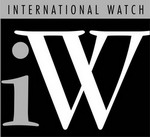
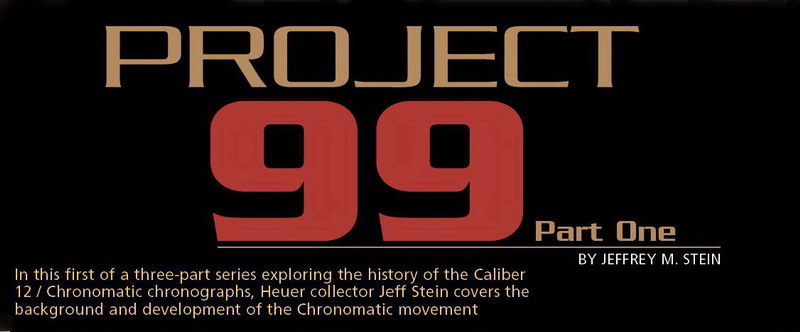
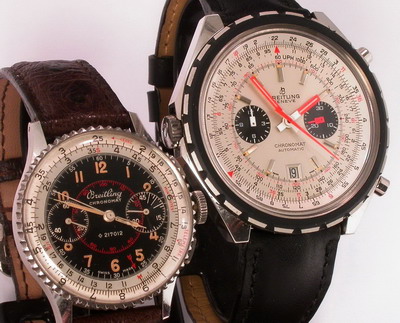
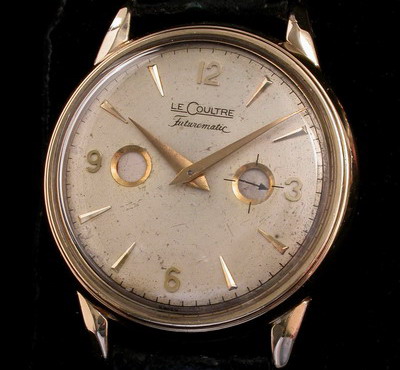
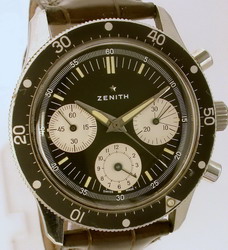
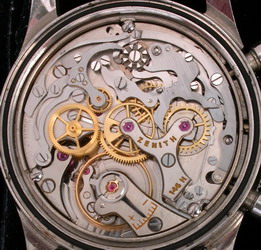
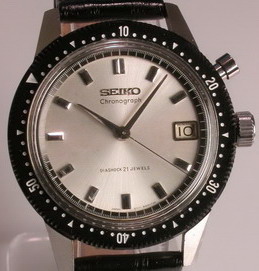
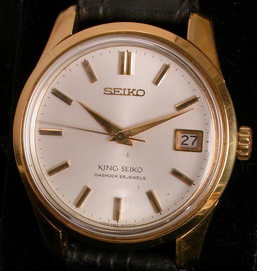 <
<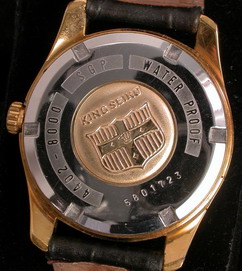
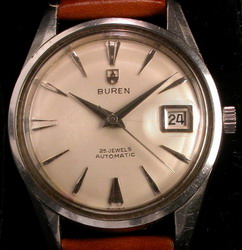 <
<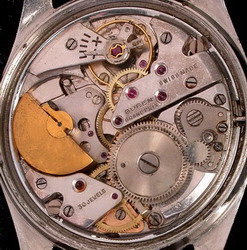
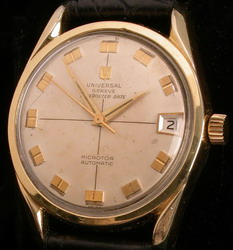
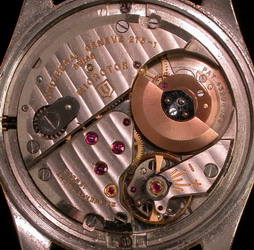
 <
<